Social media tools are a primary aspect of modern content and marketing campaigns for many businesses, but which are genuinely valuable for your business?
Google Analytics is the most important for reasons we’ll get into later, but social media tools operate in different categories and can do many things.
In this guide, we’ll take a quick look at some basic information about using social media tools, then review the best options across four main categories.
Best Social Media Tools for 2022 (Overview)
We’ve included an overview of our top picks below. For detailed information on each pick, scroll down.
- Buzzsumo
- Google Trends
- Feedly
- Scoop.it
- Sniply
- UpContent
- Venngage
- Unsplash
- Jasper
- Canva
- Unfold
- Animaker
- Infogram
- Google Analytics
- Rival IQ
- Analisa.io
- Storyheap
- Shortstack
- TapInfluence
- Keyhole
- Buffer
- CoSchedule
- HootSuite
- MeetEdgar
- HubSpot
- Sprout Social
- Zoho Social
An Overview of Social Media Tools
Social media tools are programs that make it easier to create, post, and track content performance on social media platforms like Facebook and Twitter.
Most tools specialize in different things, so businesses often end up using several tools in order instead of relying on just one.
Social media tools focus on businesses because that’s where the real money comes from, but most are also suitable for individual users.
Single users usually get all of the main features at a lower price than companies, who have to pay extra for teamwork and collaboration functions.
What are Social Media Tools in Marketing?
Social media tools include everything you can use to create and understand content on social media.
These tools include software for making posts, but also scheduling systems, graphic design, analytics, and more.
Why Do We Use Social Media Tools?
We use social media tools because they can significantly improve the return on investment (ROI) for social media marketing campaigns.
Each social network has different functions and expectations, and tools make it easier to create content that will perform well on a specific platform.
What are the Four Main Types of Social Media Tools?
There are four main types of tools: curation, creation, analytics, and management.
Curation tools focus on finding existing content and opportunities to create new content.
Creation tools emphasize making the posts, especially as it pertains to meeting the guidelines and expectations of each platform.
Some creation tools use AI to help generate content or suggestions.
Analytics tools help track performance, especially when people leave social media and visit your website.
However, analytics options also tend to show up on other platforms, so companies don’t necessarily need to get this separate from everything else.
Analytics tools also help produce reports to explain marketing performance on social media to others.
Finally, management tools include options like content schedulers that make it easy to collaborate and schedule posts.
These tend to be the most robust tools and also the most expensive.
Best Social Media Tools for 2022
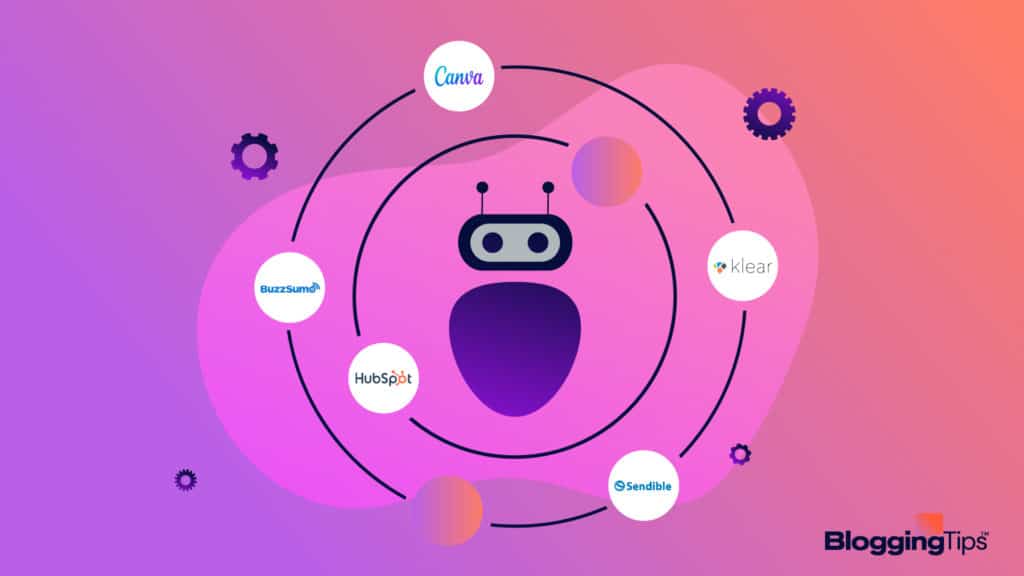
Here are our favorite social media tools in 2022, divided into sections based on what they do.
Notes on Pricing: While the prices mentioned below were accurate when we made this guide, businesses can change their pricing anytime.
Also, prices are for monthly subscriptions (when available).
Many businesses with social media tools have annual plans at a discount, averaging 10% to 20% off the monthly price.
Some also have lower-cost or free versions of their platform for qualifying nonprofit organizations, educational organizations, and similar public-service groups.
Content Curation Tools
Content curation tools help you find and share content that may be relevant.
Depending on your needs, these can help you find quality material to link to or help inspire creating your content.
Buzzsumo
Overview
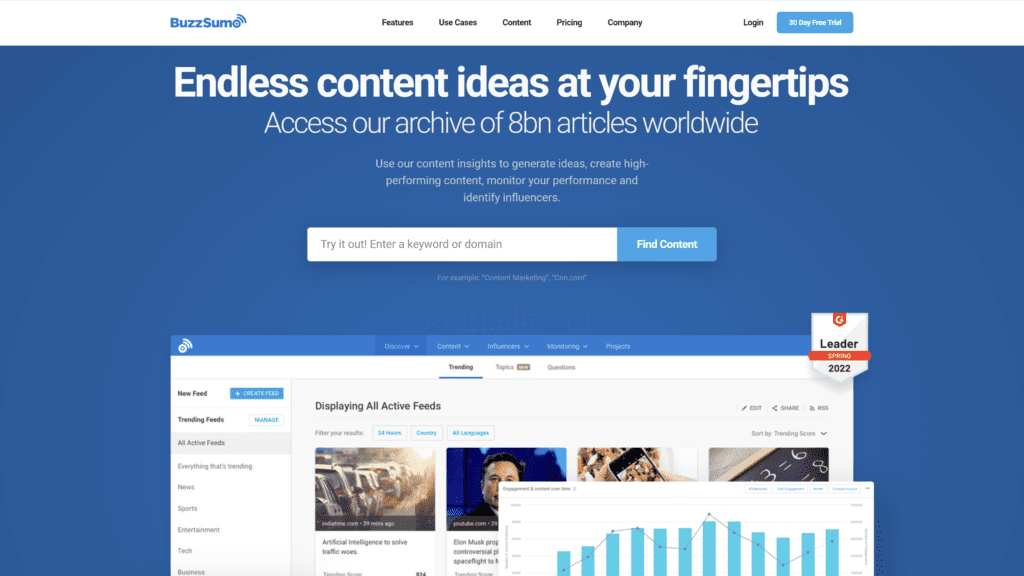
Buzzsumo is a data-based service that helps teams discover content, research marketing plans, identify influencers, and monitor trends.
It supports sorting results by time, location, language, types of writers, and more.
Buzzsumo can also track common reactions to content, such as laughter or anger.
Our Rating: 4.5/5
Best For
Topic generation and discovering trending content
Notable Features:
- Robust Discovery System: Buzzsumo can suggest keywords, content ideas and analyze competitor strategies to help you figure out what content to make next.
- Content Analysis: Buzzsumo can analyze high-performing content to help determine why it works, allowing you to use the same strategies.
- Influencers: Influencers matter on social media, and Buzzsumo can help find the most active and engaging people talking about any typic.
Pros:
- Flexible: Buzzsumo is suitable for most companies, including small businesses, and it has enough features to mesh with different marketing plans.
- Real-Time Information: Buzzsumo tracks millions of new articles per day.
It’s an effectively real-time insight into the workings of social media. - Alerts: Buzzsumo can provide timely alerts for relevant content, including tracking backlinks and letting you know when someone important is talking about a topic.
- Beginner-Friendly: Buzzsumo has guides written for newcomers to content marketing. You don’t need a lot of experience to use it.
- Facebook and YouTube Systems: Facebook and YouTube are valuable places for content, and Buzzsumo has special features for each.
Cons:
- Broad Focus: Buzzsumo does a lot well, but it’s so expansive that it doesn’t perform quite as well at specific tasks as some other programs.
- Expensive: Buzzsumo is more expensive than most of its competitors, and doesn’t offer as much data unless you get their higher-tier plans.
- Tricky Interface: Some people find the interface hard to use.
Is Buzzsumo Hard to Use?
Buzzsumo isn’t specifically hard to use, but it does take some time to get used to its interface and controls.
It also tends to show information that may not be relevant, so you have to understand what to look at and what you can ignore.
Pricing & Plans:
- Trial: 30-day free trial, available for Pro, Plus, and Large tiers.
- Pro: Basic plan, $99/month. Supports five users, ten custom feeds, and one year’s worth of data.
- Plus: $179/month, with 20% off if you buy yearly.
Best for smaller agencies and growing businesses, supporting ten users and twenty custom feeds. - Large: $299/month, with 20% off if you buy yearly.
It supports 15 users and increases its data log to two years of information. - Enterprise: Customized plans for large corporations.
No set price, scales the number of users and alerts, and includes up to five years of data.
Our Take:
Buzzsumo is a good option for most businesses.
It offers a lot of information and insights that other companies don’t, and the 30-day trial gives you enough time to test the system and learn how it works.
It’s great for research and finding influencers, but it’s pricey enough that you need to be investing a lot into marketing to get your money back.
Small businesses won’t see as much value here, as Buzzsumo ultimately works better for medium and up.
Google Trends
Overview:
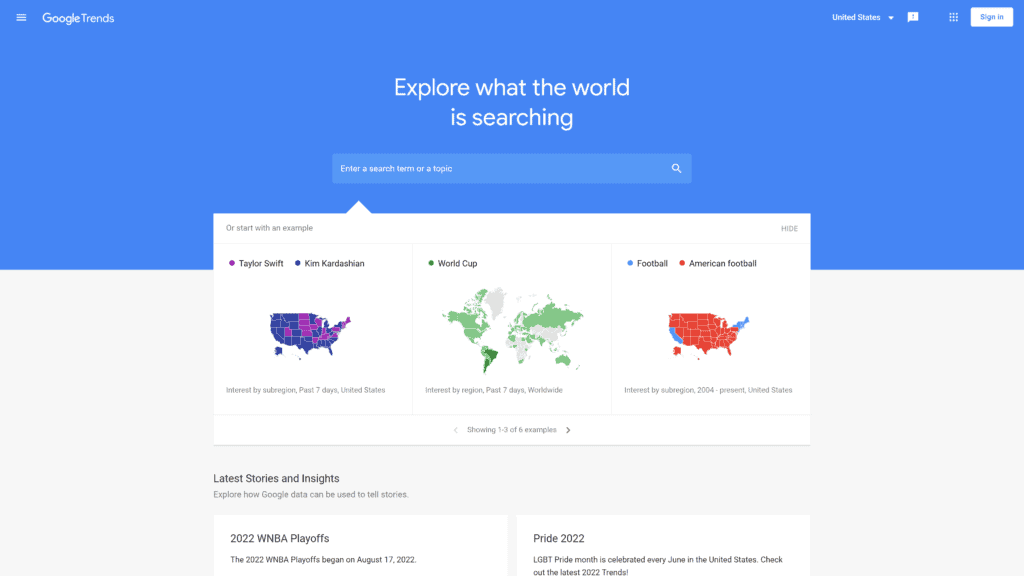
Nobody knows content like Google.
Google Trends is a simple resource that shows what people are searching for and how many searches are happening.
This provides a more neutral look at actual search performance, including on social media.
Our Rating: 3.5/5
Best For:
Tracking Overall Interest
Notable Features:
- Google’s Analysis: Google Trends displays some of the information Google has about searches.
By volume, it’s among the biggest search analysis systems in the world. - General And Specific: Google Trends shows overall search interest and information for any specific topic you want to research.
- Related Queries: Google Trends suggests topics and queries which can help you identify things your audience will like.
Pros:
- Easy To Use: Google Trends is easy for anyone to use, regardless of marketing skill.
- Geographical Interest: Google Trends can show interest in topics by region, including specific cities.
- Interest Over Time: Google Trends can show interest over many different timeframes, from a single hour back until 2004.
- Search Types: Google Trends can narrow topics by specialized categories, including news and shopping results.
These can help show companies what interests translate to product sales. - Subscriptions: Google Trends allows users to make subscriptions for getting more information on particular topics.
This is helpful for anyone who needs information regularly.
Cons:
- Limited Detail: Google Trends is good for overviews but doesn’t provide much detailed information.
- Comparative Details: Google Trends shows interest as a percent value rather than specific numbers.
- Limited Comparisons: You can’t compare too many terms simultaneously with Google Trends.
Is Google Trends Hard to Use?
No.
Google Trends is intentionally easy to use.
This is intentional, as Google usually tries to be as accessible as possible to its audience members.
It’s arguably too easy to use, as adding more features would increase its complexity.
Pricing & Plans:
- Free: Google Trends is free.
It’s one of the many services and support options Google offers to help companies perform better on the internet, thereby driving consumer engagement and ad revenue.
Our Take:
Google Trends knows what it’s doing and does its job well.
It’s great for researching interest over time and seeing if a subject is increasing or decreasing in value.
However, it doesn’t offer much granular detail, so it’s not as helpful as many other programs.
That said, it is free, and it can be a good starting point for research before you move on to something else.
Feedly
Overview:
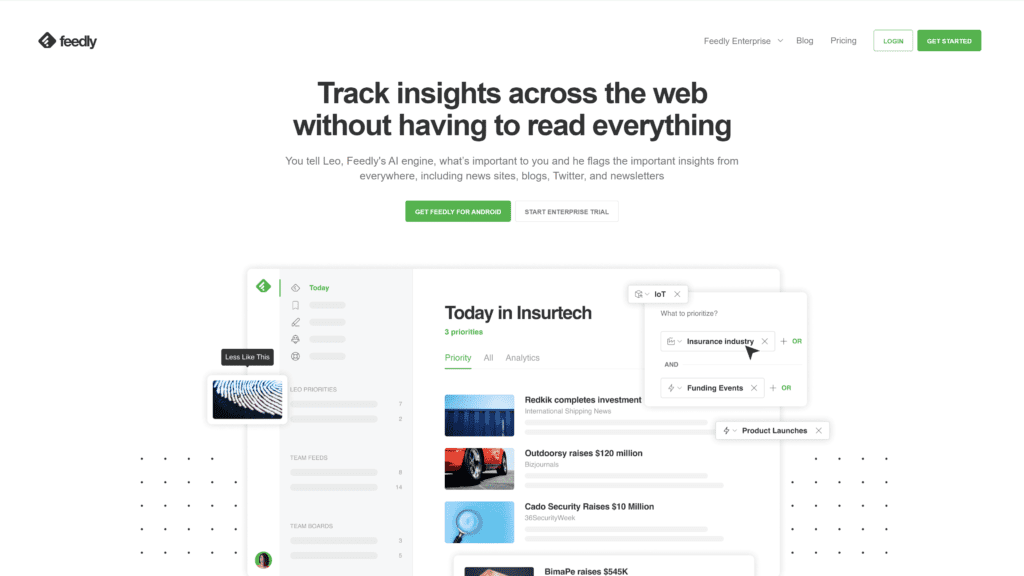
Feedly is an advanced content feed, sourcing the most relevant articles and posts from around the internet.
Its primary purpose is to cut down on information overload and let you focus on the material that’s most likely to be relevant.
The system uses AI to learn and grow over time, improving its performance the more you use it.
Our Rating: 4/5
Best For:
Staying in touch with industry developments
Notable Features:
- AI Engine: Feedly uses an AI engine named Leo to learn what matters to you and sort content more effectively.
- Privacy: Feedly supports user privacy, with its funding coming entirely from customers.
It does not sell data. - Sharable: Feedly can share content with other team members so you can keep people on the same page.
Pros:
- Excellent For Research: Feedly helps with regular research into relevant topics while minimizing duplicate articles and unnecessary extras.
- Suitable For All Companies: Feedly can work well for companies of any size, from individual users to multinational businesses.
- Alternative To Email: Feedly can help you track articles from specific sources without needing to give them your email.
- Better Over Time: Feedly is constantly improving, especially as its AI learns more about your preferences.
The people behind it also tune up the AI occasionally to increase performance for all users. - Everything Stays Together: Feedly keeps all information feeds in one place.
Cons:
- It Takes Time: Feedly needs time to learn your preferences and adjust to your tastes.
You can’t rush this process, so you have to keep using it. - Pay Points Can Feel Arbitrary: Pay points don’t make sense the same way across all companies, so you may end up paying more than you want for features.
- Limited Team Support: It’s hard to set up different teams or groups to share insights.
Is Feedly Hard to Use?
Feedly isn’t particularly hard to use because the important thing is that you keep using it.
Its AI-driven software learns more about your preferences as you engage with it.
However, this does mean that all customers start with the worst experience using the product and have to stick around as it gets better.
Pricing & Plans:
- Free: Feedly has a free plan that lets you follow 100 feeds and sort them into three folders.
This plan does not have a time limit. - Pro: The Pro plan is $6/month and includes many additional features, including up to 1000 feeds, highlights, and sharing to sites like LinkedIn.
It does not include AI curation. - Pro+: The Pro+ plan is $12/month, discounted in the first year.
It supports up to 2500 feeds and has basic AI integration.
This plan is where Feedly’s real value starts becoming apparent. - Enterprise: Feedly’s Enterprise level supports up to 7500 feeds, custom newsletters, personalized training, and advanced AI features.
Pricing is variable depending on your company’s use and needs.
Our Take:
Feedly is a good tool for minimizing interference and focusing on the most helpful articles on the internet each day.
However, it takes time to set up, and you need at least the Pro+ plan if you want to use the AI features and maximize its performance.
It’s not quite worth it below that point.
Consider trying the free version, then upgrade if you like using it.
Overview:
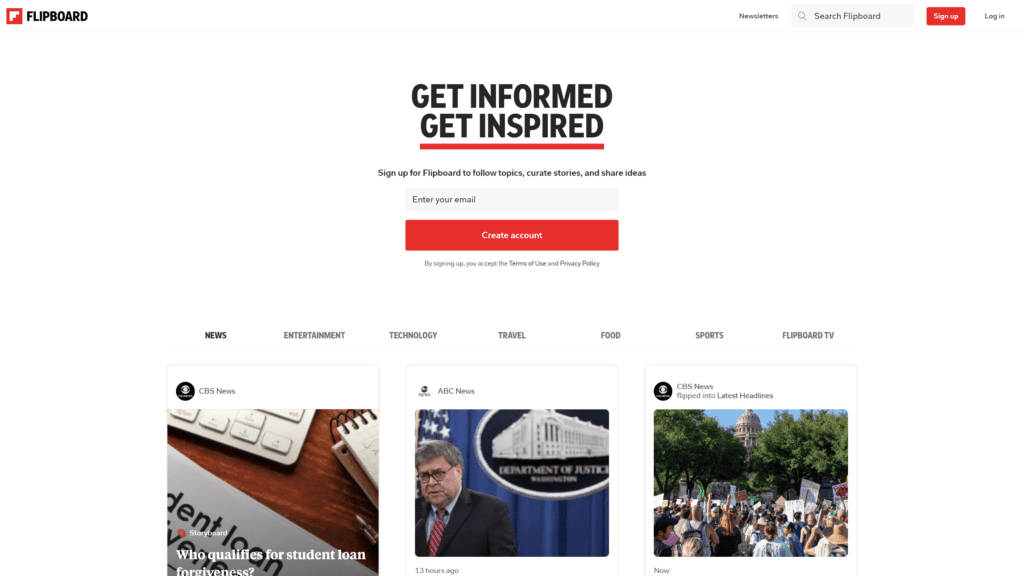
Flipboard is a news and social media aggregation tool that helps curate articles from reputable outlets.
Once it has content, it arranges it in a magazine-like format for intuitive reading of its material.
Back in 2010, shortly after its release, Apple named Flipboard the iPad App of the Year.
Our Rating: 4/5
Best For:
Reading articles and social media posts
Notable Features:
- Mobile-Friendly: Flipboard works particularly well on mobile devices like tablets, where its magazine-like design feels more natural than on a mouse-and-keyboard.
- Multi-Source Design: Unlike most curation apps, Flipboard can source content from social media alongside traditional news and blog posts.
- User-Created Magazines: Flipboard lets users create and share magazines.
This can be ideal for marketing to customers and sharing relevant information within a business.
Pros:
- Extremely Polished: Flipboard is a well-established app that’s gone through many improvements over its lifespan. It’s much more solid and complete than many newer products.
- Content Across Time: Flipboard has plenty of recent magazines, but its content can also include older material that’s still relevant.
- Cross-Platform: Feedly works across many different platforms, including regular internet browsers.
- Narrower Feeds: Feedly can focus on specific, narrow topics.
This setup is better than trying to follow everything at once. - Frequent Updates: Flipboard still gets regular updates and fixes most problems quickly.
Cons:
- Ad-Heavy: Flipboard relies on ads for revenue, and there’s no real way to get rid of them.
- Low-Quality Sources: Many of Flipboard’s news sources aren’t reputable.
- Information Overload: It’s easy to follow too many magazines or social sources, making it challenging to keep up.
Is Flipboard Hard to Use?
Flipboard is easy to use, especially if you’re reading content on a tablet.
However, it will take a little training if you want to make your magazines and have them look good.
Pricing & Plans:
- Free: Flipboard is free for all users, including for creating and publishing your magazines.
It gets revenue by running advertisements inside magazines that users make.
Our Take:
Flipboard is an excellent source for news if you learn to manage its feed.
They claim more than 100 million monthly active users, and the ability to create magazines about specific topics helps them stand out from other news sites.
For businesses, the best use is either in subtle advertising or in creating magazines for employees to read.
Scoop.it
Overview:
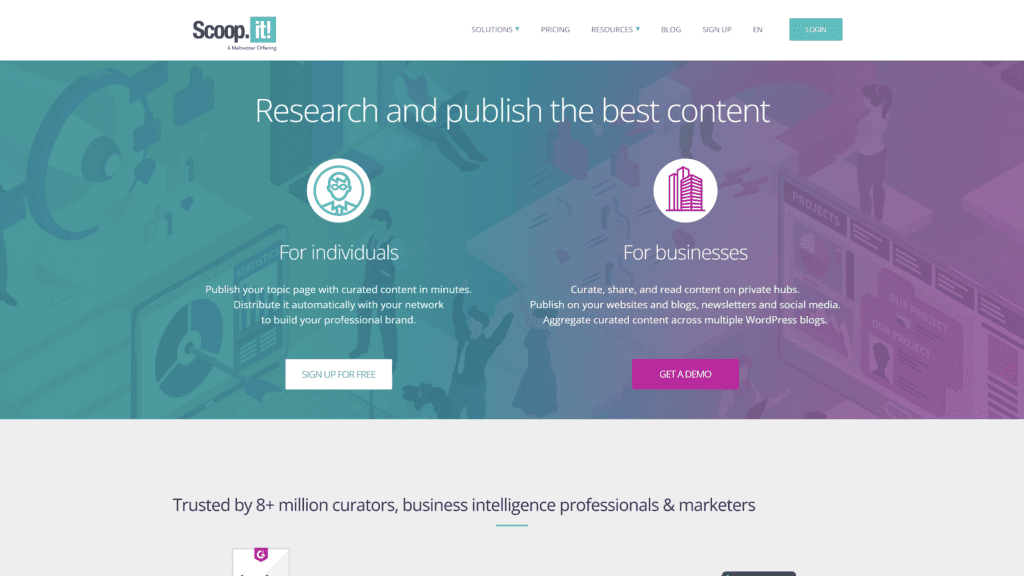
Scoop.it is a content curation service that helps locate new, high-quality material on specific topics across the internet.
Individuals can publish topic pages with crafted content, while businesses can create websites, newsletters, and more.
Our Rating: 3.5/5
Best For:
Internal Business Support
Notable Features:
- Rapid Publication: Scoop.it allows you to create and share web pages with content on various topics.
- Email Support: Scoop.it allows for creating and sending emails, including within an organization.
- Social Network Support: Scoop.it works well with most social networks, including SSO and intranet options.
Pros:
- Good for Small/Medium Businesses: Scoop.it is particularly effective for smaller companies, though not as valuable for larger organizations.
- Finds Quality Content: Scoop.it is good at finding content that performs well, and curating this can create higher-quality pages.
- Internal Company Support: Scoop.it works well for sharing content within a company to keep people on the same page.
- Supports Thought Leadership: Scoop.it is effective at promoting thought leadership by focusing on quality content.
- Multi-Network Support: Scoop.it can help publish to multiple networks simultaneously.
Cons:
- It Takes Time To Learn: It can take a few weeks to truly master this system, which significantly adds to the investment of using it.
- Limited Share Frame: It can be challenging to find content that’s too new, which can give the impression of being slower or more out-of-touch than competitors.
- Bad For Niche Markets: Scoop.it isn’t nearly as effective for smaller markets as larger ones.
Is Scoop.it Hard to Use?
Scoop.it is harder to use than some of the other options on this list.
It takes time and practice to learn how to use it effectively.
Pricing & Plans:
- Free: The free plan has an unlimited duration, but it’s limited to one user for creating topic pages and can’t distribute content, create newsletters, or get analytics.
For companies, the free tier is just to look at the system, not use it. - Pro: The Pro tier adds several features for $17.99 a month, including adding custom branding, sharing to social channels, and basic analytics.
- Plus: The Plus tier is pricier at $79/month but supports up to five users with additional social support, WordPress access, newsletter creation, and access to Google analytics.
- Enterprise: The Enterprise tier has custom pricing but gives access to the entire list of features.
This tier includes secured topics, API support for website distribution, automated newsletter creation, personalized training, and more.
Our Take:
Scoop.it is most effective if you want to reshare high-quality content to build a reputation or create newsletters to share within an organization on a relevant topic.
It’s not as good for researching specific topics, and its inability to work with hot new content is a noticeable limit.
It’s not a bad service, but its use case is narrower than other options on our list.
Sniply
Overview:
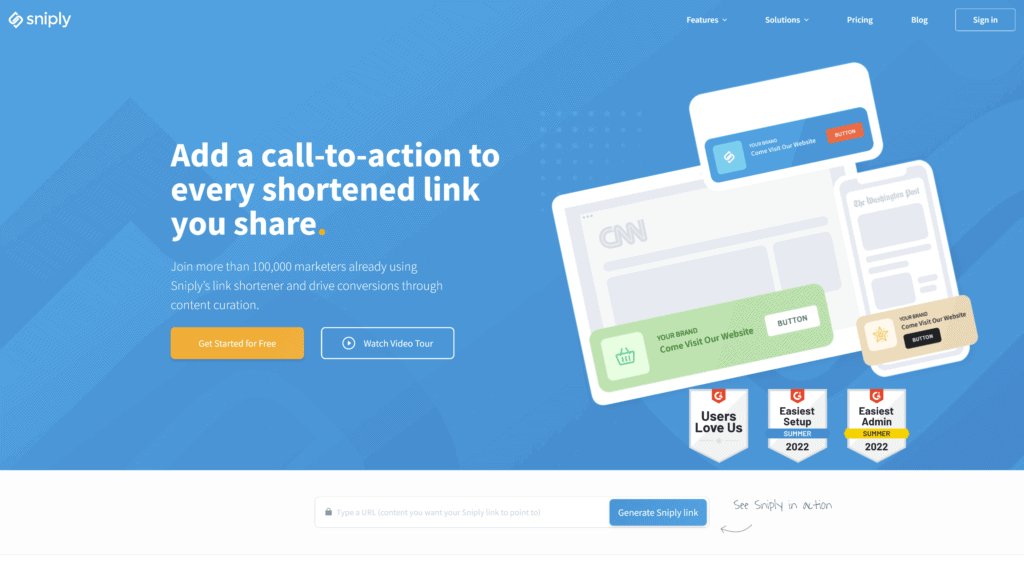
Sniply is an advanced link shortener.
In addition to making links more attractive, it allows you to add customized messages and designs to links and overlay content on destination sites.
Our Rating: 5/5
Best For:
Linking to Other Content
Notable Features:
- Adds Calls to Action: Sniply allows you to add a call-to-action to a link, which is fundamentally better.
- Conversion Optimization: Sniply can track users through making a purchase, which ensures you’re making informed decisions for optimization.
- Customizable Link Boxes: You can select colors, text, icons, and more for each link.
Pros:
- Excellent Customization: Sniply allows for an impressively large amount of customization for each link.
- More Calls to Action: Having more calls to action helps improve conversion rates.
- Great Support For Free Users: Some services heavily limit what free users can do, but Sniply is powerful even before you upgrade to a paid plan.
- Excellent Social Media Links: Sniply offers better links on Social Media than most other services.
- Quality Analytics: Sniply includes robust analytics to track performance and help you optimize links.
Cons:
- Banned on Some Sites: Sniply is blocked on some websites, and you can’t control this from your end.
- Limited Text Space: Sniply has minimal space for customized text, which limits what you can do with it.
- Expensive: While the free version is decent for small users, the paid plans are fairly expensive for what they offer.
Is Sniply Hard to Use?
No.
Sniply is easy for most people to use.
Pricing & Plans:
- Free: Sniply’s free plan supports 500 clicks and 20 links per month.
All of its other plans have a 14-day trial. - Basic: The Basic plan is $29/month and supports up to 5000 clicks across 1000 links.
It also adds another brand profile. - Pro: The Pro plan is $79/month, supporting 20,000 clicks across 5000 links.
It also adds four brand profiles and two team member slots.
They claim this is the most popular plan. - Business: The Business tier supports 50,000 clicks and 10,000 links a month, plus adding another four brand profiles and two team member slots.
- Agency: The Agency level supports 250,000 clicks across 50,000 links, with more brand profiles and team member slots.
Notably, there is no unlimited-clicks tier.
Our Take:
Sniply is excellent at what it does, which is improving linking to other sites.
Though moderately expensive, it can pay for itself with a higher return on investment, and its free tier is a great way to start learning it.
UpContent
Overview:
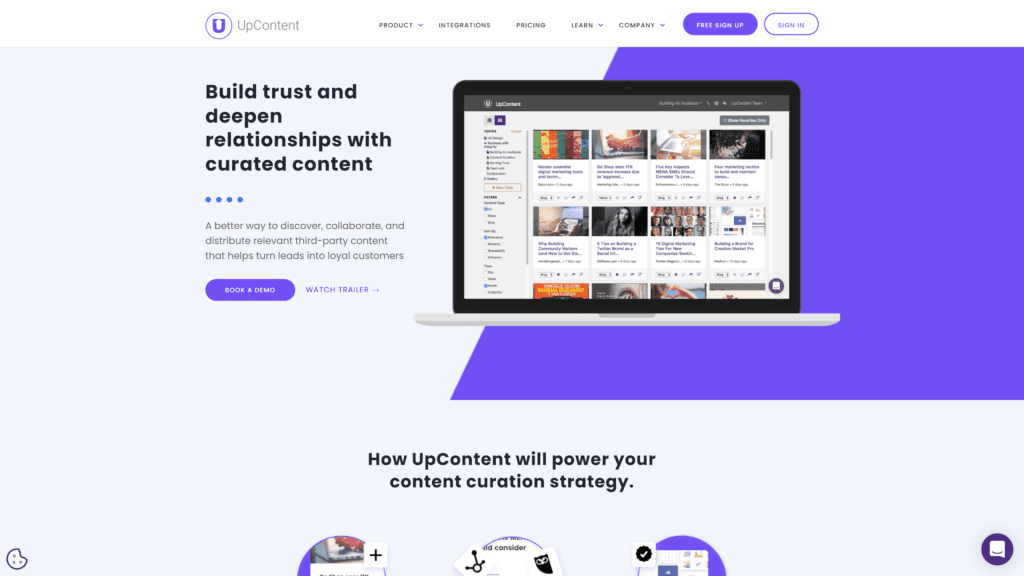
UpContent is a content curation system for discovering and distributing content.
It also supports conversion systems to help improve ROI.
Our Rating: 4.5/5
Best For:
Extra Features
Notable Features:
- Extensive Analysis: UpContent analyzes millions of articles per month, with its algorithm helping find the best for each topic.
- Easy Content Sharing: UpContent also makes it easy to share content with coworkers or an audience.
- Flexible Automation: UpContent allows creating specific automation rules for content.
This automation can simplify a single step or the entire process, giving you more control over when and how to engage with the content.
Pros:
- Flexible Scanning Range: UpContent can focus on new or old content.
Most of its competitors have a single timeframe for curating content. - Efficient Curation: UpContent analyzes enough content to produce good results on most subjects.
- Include Own Content: UpContent’s browser extension support allows you to add more of your content to what you share.
- Solid Integration: UpContent integrates well with many other tools.
This integration ensures a smoother workflow at most companies. - Excellent Customer Support: UpContent has a great customer support team.
They’re usually responsive to problems, and the system has a lot of documentation.
Cons:
- Best In English: UpContent isn’t as effective for non-English articles, which inhibits its use for many international companies.
- Tricky Setup: Getting the exact topics you want can be a challenge. It takes time and testing to set up the parameters for each query.
- Limited Video Support: UpContent isn’t particularly good for integrating and sharing videos, which are an important part of advertising for many businesses.
Is UpContent Hard to Use?
UpContent is a little tricky to use.
It works quite well, but it takes practice and testing to ensure you’re using the right queries.
Pricing & Plans:
- Free: UpContent has a free mode, offering curation for one topic to one user.
his is essentially a test for its functions and is not good enough for businesses. - Sharer: At $15/month, the Sharer tier supports following ten topics.
It has limited integration for partners but does include basic support and custom summaries for articles. - Curator: The Curator tier is $49/month and includes all partner integrations, RSS support, custom website support, and premium onboarding.
- Engager: The Engager level is $95/month and supports up to 50 topics across 3 collections.
It also has custom calls to action, email integration, and custom article images.
This is the best option for most mid-size businesses. - Orchestrator: This tier is $265/month and allows for up to 100 topics across 9 collections.
Its actual features aren’t much different than Engager, but it supports additional collections at a lower price. - Enterprise: Like most of these companies, UpContent has a custom business tier with personalized pricing for particularly large organizations.
Our Take:
UpContent is an excellent content curation tool.
It has both the scale and the features to be meaningfully valuable to businesses of all sizes, and at a reasonable price point.
It takes some practice to set queries right, but the premium onboarding at higher levels helps a lot.
Content Creation Tools
Content creation tools help make the content you’re going to post on social media.
The more you can simplify this process, the better.
Venngage
Overview:
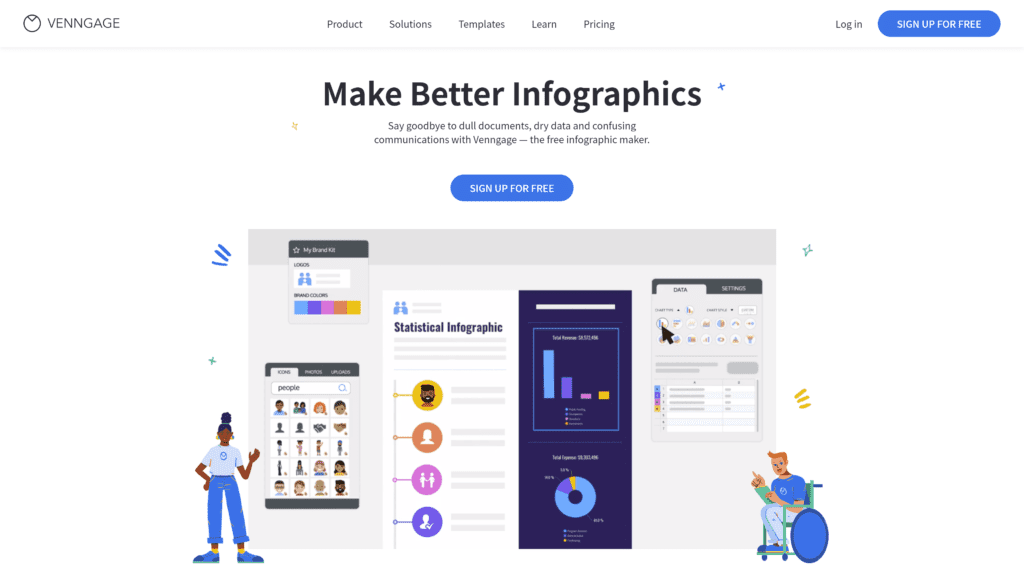
Venngage is an infographic-creation tool.
It includes over 7500 templates with easy customization options to display data, with a simple interface that doesn’t require a degree in graphic design.
Our Rating: 5/5
Best For:
Infographic Production
Notable Features:
- Automated Branding: Venngage supports automated branding with things like color templates that allow for consistency in your images.
- Flexibility: Although focused on infographics, Venngage also allows for making visuals like diagrams. This flexibility makes it even more powerful.
- Stock Photos: Venngage has stock photos through Unsplash, which adds to the variety of image types you can include.
Pros:
- Outstanding Templates: Venngage has templates for almost any conceivable need, complete with variations to display more or less information than usual.
- User-Friendly: Venngage is easy for most people to use, with or without training in art and graphic design.
- Excellent Auto-Saving: Venngage has frequent auto-saves to help avoid losing content, especially with the precision required for many infographics.
- Easy Customization: It’s easy to edit most parts of any template, including the colors in different areas.
- Team Support: Venngage supports teams, allowing multiple users to access and edit content as necessary.
Cons:
- Relatively Expensive: Venngage is more expensive than many other services, especially if you want to access its full suite of features.
- Tricky Controls: Some of the controls aren’t as intuitive as they could be, which slows down the graphic production process.
- Frequent Similarities In Templates: Some templates are only a little different from others, which minimizes their value compared to a single easily-editable option.
Is Venngage Hard to Use?
No.
Venngage is user-friendly and easy to get started with, though it may take some time working with their tools to get a fully custom infographic.
Pricing & Plans:
- Free: Venngage’s free plan supports up to five designs at once, with access to diverse icons and widgets. It allows up to six image uploads.
Images can only be shared publicly at this tier. - Premium: The Premium tier is $19/month/user, offering unlimited designs, private sharing, PNG exports, and up to 50 image uploads.
- Business: The Business tier is $49/month/user, supporting teams of up to 10 members.
It mainly adds collaboration tools, such as folder organization, real-time collaboration, a brand kit, and phone support.
This tier supports up to 500 image uploads. - Enterprise: The customized enterprise tier starts at $499/month and goes up from there.
Its primary features are the same as the Business tier but this level comes with a dedicated account manager, live onboarding, team training sessions, and an opportunity for custom-built features.
Our Take:
Venngage is quite expensive because its pricing at lower tiers is per-user.
However, its power and versatility make it a valuable tool for companies that need to produce a lot of custom graphics, and that’s where it shines.
Having a few accounts at the Business tier is probably the best option for mid-size businesses.
The free tier isn’t particularly good, but it is a nice way to test their software before you buy.
Unsplash
Overview:
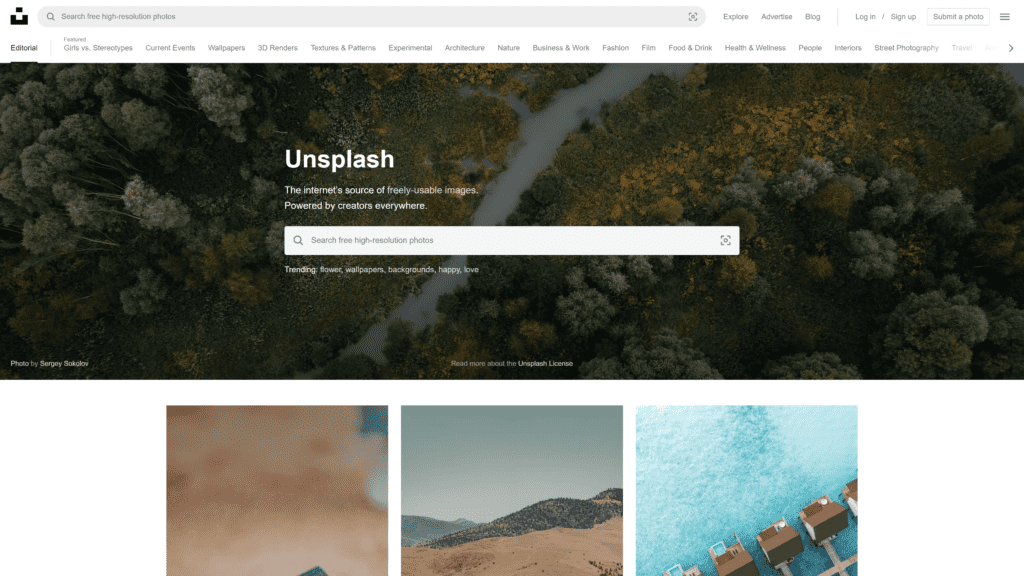
Unsplash is a database of millions of freely-usable images.
Most content is donated by photographers and operates under the Unsplash license, which allows for commercial use (though not selling them as photos without significant modification).
Unsplash does not require attribution, though companies can voluntarily credit photographers.
Our Rating: 4.5/5
Best For:
Free Photographs
Notable Features:
- Free Use: Unsplash has a free, business-friendly license that makes it ideal for any company looking for high-quality stock images.
- Huge Database: Unsplash has millions of images available for use.
- Variety: Unsplash’s gallery includes a lot of variety, from different types of backgrounds to high-quality wallpapers and more.
Pros:
- Hand-Curated: Each image on Unsplash is hand-selected to help ensure a basic level of quality throughout the gallery.
- Community Favorite: Unsplash is easily among the best sources for free photographs on the internet. It also listens to its community and has been working on ways to highlight particularly good artists.
- Great Way To Find Photographers: Outside of its existing stock art, Unsplash is an excellent way to find photographers worth hiring.
- No Account Necessary: Unsplash doesn’t require users to have an account, although this can help save images.
- Multiple Image Formats: Many pictures on the site are available in several image formats, which is a must for producing high-quality content.
Cons:
- Can Be Hard For Business: Much of Unsplash’s gallery is artistic or abstract.
These aren’t always good images for business purposes. - Finding Individual Images Can Be Heard: Unsplash has a huge database.
If you don’t already have a clear image in mind, it may take some time to find the right keywords to describe what you want and narrow down your options. - Limited Monetization: Unsplash has been operating for years, but makes money primarily through ads and isn’t quite as stable as some other services.
It’s possible a market disruption could shut them down.
Is Unsplash Hard to Use?
No.
Unsplash is primarily an image gallery with an attached search engine, so it’s easy to use as long as you can describe what you’re looking for.
However, it may take a bit of trial and error to find images suitable for a business
Pricing & Plans:
- Free: Unsplash is completely free for users.
All of its images are available under its license for both commercial and non-commercial purposes.
The only things it doesn’t allow are making a competing service and selling the photos without major modifications.
Our Take:
Unsplash is an outstanding resource for high-quality photographs.
It would be worthwhile with a paid plan, but being free makes it even better.
Its only real flaw is that many images are too abstract for businesses, so you may need to get creative in how you search the database.
Jasper
Overview:
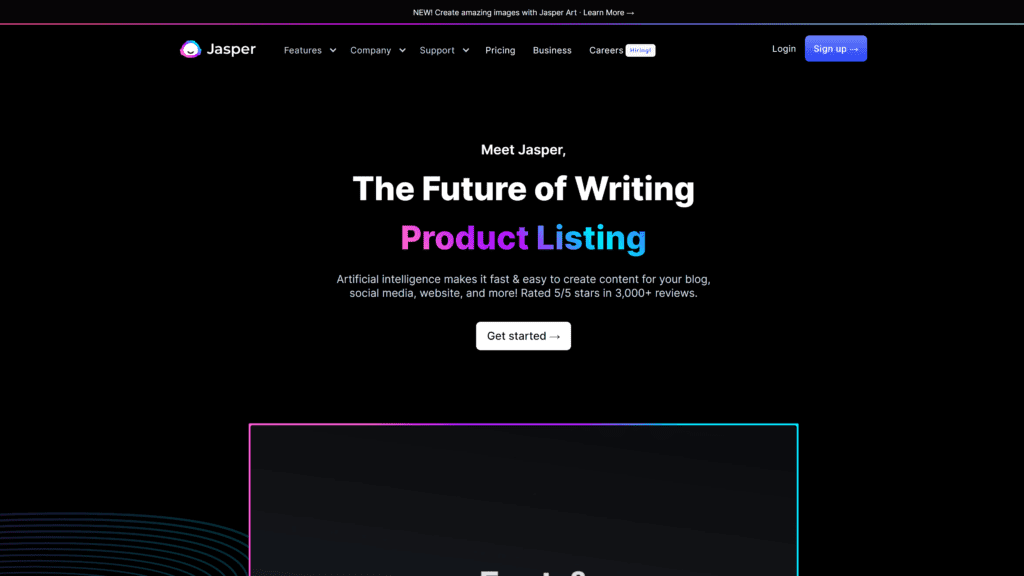
Jasper is an AI-powered writing assistant. It can help produce content, ideas, and variations on existing articles while avoiding plagiarism.
It’s particularly effective at creating drafts that you can modify.
Our Rating: 4/5
Best For:
Drafting Content
Notable Features:
- Flexible Idea Generation: Jasper can help create anything from blog post outlines to entire frameworks for marketing.
It can also suggest paragraphs or summarize text to help you scan content better. - Excellent Ad Generation: Jasper is excellent at writing ad copy for places like Facebook and Google.
- Video Script Support: Although mainly focused on writing, Jasper can also help produce scripts, ideas, and descriptions for video content.
Pros:
- Huge Variety Of Features: Jasper has many specific features and settings, from simplifying text to responding to reviews.
It’s particularly good for users who aren’t confident in their writing. - Natural Language Interface: Jasper has an AI-based assistant that can work with a natural language interface, making it easier to describe what you want and get help.
- Generally Accurate Content: Jasper usually produces factually-accurate content, which is important when you want to publish something on the internet.
- Grammarly Integration: Jasper can interface with Grammarly to double-check spelling and sentence structure.
- Simple Interface: Jasper has a user-friendly interface that works well for anyone that isn’t used to writing.
Cons:
- Not As Flexible As Human Writers: Despite its value, Jasper can run out of ideas quickly and can’t expand on things as well as a capable human writer.
It also tends to perform significantly worse on complex or technical topics. - Bad Results Still Cost You: Jasper uses a per-word model for pricing.
If it produces unusable content, which it does regularly on many topics, you’re still paying for that. - It’s Hard To Verify Quality In Other Languages: Jasper has support for languages besides English, but unless you’re natively fluent in them, it can be hard to understand the output quality.
With its tendency for unusable results, that’s an issue.
Is Jasper Hard to Use?
No.
Jasper’s basic features are easy to use, though mastering advanced elements like its AI integration will take practice.
Pricing & Plans:
- Starter: Jasper’s Starter plan begins at $29/month for 20,000 words.
It comes with chat support for help using the system. - Boss Mode: Jasper’s Boss Mode starts at $59/month for 50,000 words.
It includes a Google Docs-style editor, full access to the AI, better templates, and priority chat support. - Business: Jasper has a variable-price business mode that offers support for custom word amounts and users.
This tier comes with flexible pricing, an account manager, onboarding sessions, and better technical support.
Both Starter and Boss modes can have different prices depending on how much content you want to produce.
The company offers a money-back guarantee if you don’t like the results and want to stop using Jasper.
Our Take:
Jasper is an excellent service for generating ideas and producing basic content for the web.
It’s fast and powerful on generic topics.
However, it does break down many complicated ideas, and readers will often notice if the copy you write seems too artificial.
Consider this a supplement for a human writer, not a replacement.
Canva
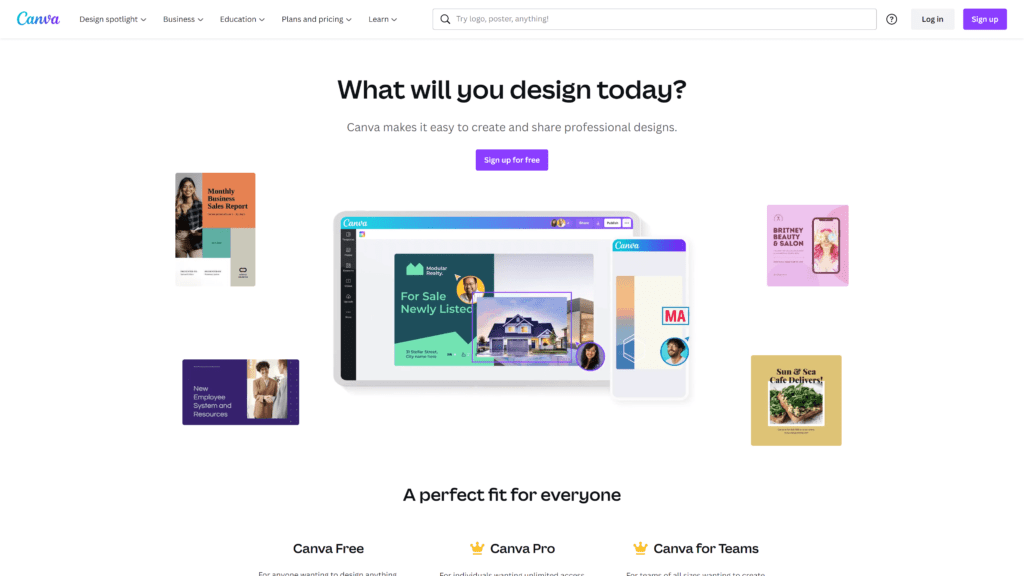
Overview:
Canva is a template-based graphic design tool that supports many needs, from enhancing images to trimming videos, adding text to photos, or creating infographics for business presentations.
Our Rating: 4/5
Best For:
General Image Editing
Notable Features:
- Huge Suite of Features: Canva has an exceptionally wide suite of features, ensuring it can meet almost any regular graphic design needs.
- Includes Video Editing: Unlike other services, Canva allows for complex video editing instead of limiting itself to still images. This includes sound effects.
- Team Support: Canva has options for collaborative production.
Pros:
- Suitable For Most Media Production: Canva’s support for images and videos makes it an outstanding choice for creating almost any type of media your business may need.
- Brainstorming Tools: Canva supports brainstorming sessions to find new ways to produce content. This is a feature most competitors are severely lacking in.
- Easy Templates: Canva has thousands of templates that serve as a starting point for creating good-looking content.
- Brand Support: Canva’s Brand Kits can help ensure people are always using the right colors and fonts for consistency across your social media posts.
- SSO: Canva supports Single Sign-On, allowing people to access multiple applications with a single username and password.
At larger organizations, this can significantly reduce the amount of tracking necessary.
Cons:
- Image Editing Hiccups: Canva sometimes makes errors with image editing, such as not aligning things quite perfectly.
It may also fall short for resizing elements in templates. - Limited Text Options: Many of Canva’s tools have strictly limited text editing tools, which can make them much harder to use if you have specific needs.
- Irregular Uptime: Canva goes down regularly, which can be problematic if you need to use it right away.
Stability is essential for many businesses.
Is Canva Hard to Use?
Most of Canva’s tools are intuitive for people who know a little about image editing and graphic design.
However, it has so many tools that it can take time to figure out the right one for a scenario.
Pricing & Plans:
- Free: Canva’s free plan gives access to its drag-and-drop editor, over a quarter million free templates, and over a million free photos.
However, it doesn’t have many organization or business-oriented features. - Canva Pro: Canva’s regular premium tier, Canva Pro, is $12.99/month.
It adds folders, better support for resizing, scheduling social media posts, 1 TB of cloud storage, 100 brand kits, and more features for businesses. - Canva for Teams: Canva’s group-oriented plan starts at $14.99/month for five people, with the price going up if you add more users.
This adds many collaborative functions, including activity logging, approval workflows, team reports, and paying as you go.
Outside of its regular plans, Canva has special free modes available for students and teachers below the college level, as well as free access to Canva for Teams for nonprofit organizations.
Our Take:
Canva is a powerful and flexible graphic design tool, ideal for creating both images and videos for social media.
It’s quite affordable, too, especially for the features available.
However, only people who are familiar with making images can get the most from this system, so it’s harder for anyone else to produce the best results.
Unfold
Overview:

Unfold is an app-based photo and video editor for posting to social media, particularly image-based ones like Instagram and Snapchat.
It also supports making a hub page for linking out to your other content.
Our Rating: 5/5
Best For:
Instagram Stories
Notable Features:
- Outstanding Templates: Unfold offers templates for uploading to social media.
These are usually high-quality options, to the point that many larger accounts use them. - Easy Image Editing: Unfold allows adding text, filters, and other effects to both still images and videos.
- Feed Planning: Unfold can make it easier to see how your feed on Instagram will look after adding planned content.
Pros:
- Professional Quality: Unfold is one of the highest-quality image management and editing services for Instagram.
Both Apple and Google consider it a Best of the Year application, which is no minor feat. - Personal Site Creator: Unfold can help you create a customized personal website that links elsewhere on the web. Although not a full website creator, it’s a great touch.
- Easy Editing: Unfold has a user-friendly image editing system.
Graphic design is hard, and editing photos with people is even harder, so this is a valuable inclusion. - Template Selection: Unfold has several hundred templates, each carefully designed to produce the best results.
Their performance so far demonstrates that this approach works. - Exclusive Material: Unfold has some exclusive content, including fonts and tools that can be hard to find elsewhere.
Cons:
- Limited Free Mode: The free mode is extremely limited, with strict limits on what you can do.
You can purchase some things like templates individually, but this isn’t nearly as powerful as the subscription levels. - Hard To Use In Groups: Unfold can be difficult to use in groups or help collaborate on content.
You may find it easier to have a single account that one person manages. - Limited Customer Support: It can be hard to get in touch with the developers if you’re having a problem.
Is Canva Hard to Use?
No.
Canva is a user-friendly app, and it should feel familiar to anyone who has experience on Instagram or similar sites.
Pricing & Plans:
- Free: Unfold’s free tier includes basic features and a small handful of templates.
Users can buy additional templates for a small price. - Unfold+: The basic paid tier, Unfold+ is available at $2.99/month.
It provides access to all template collections and some other exclusive content, including fonts and stickers. - Unfold Pro: The advanced plan, Unfold Pro is $12.99/month and is oriented toward businesses.
It has support for additional customization and features, including Brand Kits, web dashboards, custom fonts, and more.
Our Take:
Unfold is a great tool for Instagram, and its record of success is so high that it’s almost harder to find serious accounts that aren’t using it.
This is easily a top choice for Instagram specifically and other photo-based social media sites generally.
However, it’s not necessary for any companies who aren’t using those networks.
Animaker
Overview:
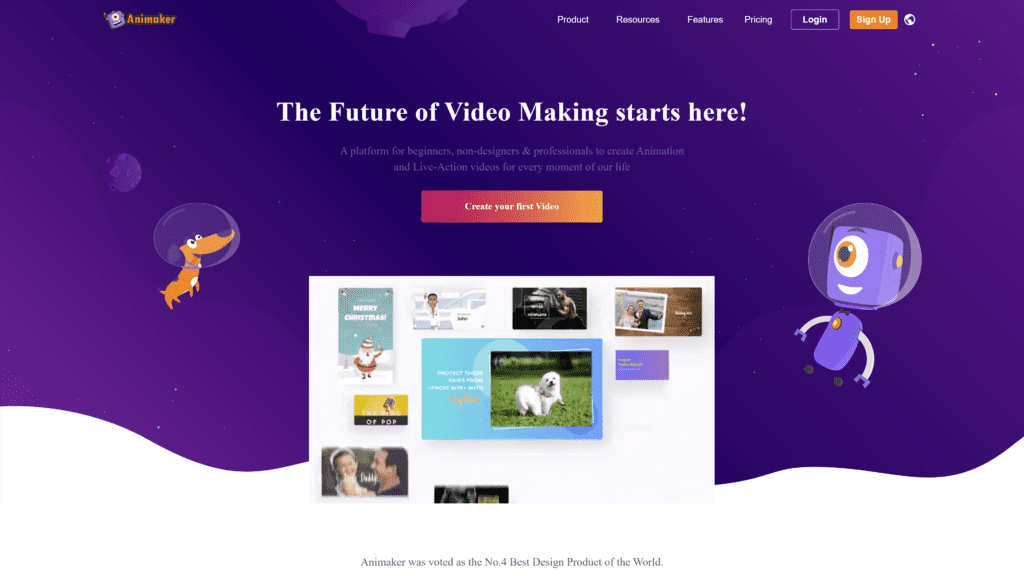
Animaker is a video-creation platform.
It’s particularly good at creating simple animated videos thanks to its huge catalog of assets, but it can also work with photos and existing videos in up to 4k quality.
Our Rating: 4/5
Best For:
Making Video for Any Platform
Notable Features:
- Huge Asset Library: Animaker’s library includes icons, backgrounds, images, animated character parts, videos, and much more.
- Excellent Performance: Animaker runs on HTML5, which has extraordinarily broad support across browsers and ensures good performance on most devices.
- Professional Video Templates: Expert-designed templates provide a good framework for creating videos, which is important.
Videos are fundamentally far more complicated than still images, and every bit of assistance matters.
Pros:
- Excellent for Beginners: Animaker is beginner-friendly and has features in place to guide users through the video-making process.
It’s possible to create a character, add some text, and then put in some animation to make a basic explanation video in just a few minutes. - Outstanding Movement Options: Animaker supports a large variety of movement options for animations, which makes it much easier to create anything you can envision.
- Not Limited To Cartoons: Animaker specializes in cartoon-style videos, but it can also work with other types of content to meet your needs.
- Automatic Lip-Sync: Animaker’s system supports lip-syncing to existing audio, which is a huge time-saver for creating talking characters.
- Huge Library Of Stock Assets: Animaker has access to over a hundred million stock assets through services like Getty and Giphy, plus royalty-free music and sound effects.
Functionally, this is all the stock assets anyone could need.
Cons:
- Slow Rendering: Animaker can take longer to render output than some other services.
Making a video may require rendering several times to check for errors, so this adds up. - Not As Good On Older Machines: Animaker will work on almost anything that supports HTML5, but performance is noticeably worse on older computers.
- Only Available Online: Animaker doesn’t have an offline mode, which can be annoying for anyone expecting inconsistent internet access.
Is Animaker Hard to Use?
Animaker is as easy to use as a robust video editor can realistically be.
It’s not as simple as many of the other tools on this list, but that’s inevitable in video production.
Expect to spend some time mastering its functions.
Pricing & Plans:
- Free: The free plan includes up to five video downloads (with watermarks) a month, as well as only the most basic editing features. This isn’t suitable for businesses or serious users but can be a good way to test the service.
- Basic: The Basic tier is available at $20/month and supports five premium video downloads (with no watermarks).
It also has automatic video resizing and background removals but does not include commercial rights. - Starter: The Starter tier has 10 premium video downloads each month, and is the first tier to offer commercial rights for users.
It upgrades the resolution to Full HD (1080p), but aside from the quality and commercial rights is otherwise similar to the Basic tier.
This level is $35/month. - Pro: The Pro plan is $79/month, with 2K resolution videos up to 30 minutes long.
It also has support for custom fonts and other enhancements. - Enterprise: The custom-price Enterprise plan ups the maximum quality to 4k video, with unlimited video downloads a month.
This tier adds special features, including a reselling license, the ability to save templates, and time-saving priority rendering on their system.
API integration and custom reports are also available here.
Our Take:
Animaker is an excellent tool for any business that wants to add video content. It’s best for making cartoon-style animations. While it can handle up to 4K videos, any company producing at this quality level is probably using other video editing software already.
Infogram
Overview:
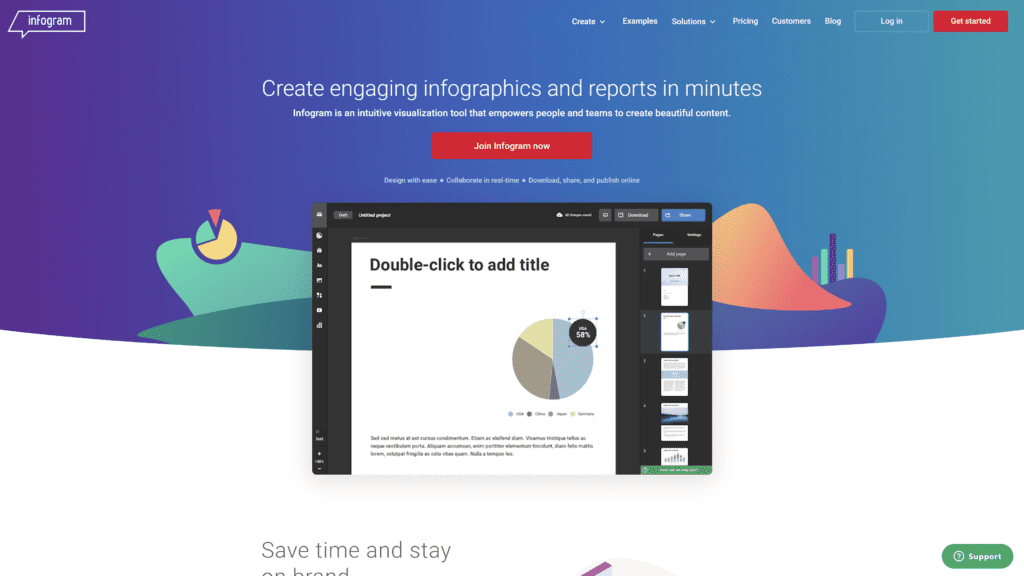
Infogram is a visualization tool for creating graphics, charts, and similar information. It can easily add data from spreadsheets to create real-time updates and results, with drag-and-drop positioning to make editing each image easier.
Our Rating: 4/5
Best For:
Business Graphics
Notable Features:
- Numerous Template Categories: Infogram has templates for a wide selection of business categories, including infographics, slides, maps, and social media visuals.
- Interactive Content: Infogram can produce interactive materials, including charts and maps. This is a step beyond preset animations and can drive powerful engagement on social media.
- Excellent Branding: Infogram offers a solid brand guideline system that can keep everyone on the same page.
Pros:
- Excellent Collaboration: Infogram supports teamwork by allowing multiple users, letting administrators set permissions for team members, and even saving previous versions of graphics so it’s possible to restore content from backups.
- Internal Analytics: Infogram has built-in analytics for things like viewer demographics and engagement with interactive elements.
- Mobile-Friendly: Infogram produces mobile-friendly content that adjusts well to smaller devices.
- Wide Use Scenarios: Outside of business, Infogram also works well for nonprofits, schools, and even government agencies.
- User-Friendly Editor: Infogram runs on a drag-and-drop editor that simplifies the image-making process.
Cons:
- Best For Simple Images: Infogram isn’t very good at most complex visualizations. It does better with basic charts and graphics.
- Moderately Expensive: Infogram is relatively expensive despite the simplicity of most of its visuals. In fairness, the ability to create interactive charts is still valuable.
- Imperfect Output For Social Media: Infogram won’t always save content in the right format for social media sites. You may need to resize it after downloading it.
Is Infogram Hard to Use?
No. Infogram is user-friendly and doesn’t require much technical knowledge. However, like all image editors, it can take some practice before you get good at using it.
Pricing & Plans:
- Free: Infogram’s Basic tier is free, offering interactive charts, ten projects, and 13 map types. It supports importing data but has limited saving and publishing options.
- Pro: The Pro tier is $25/month and supports up to 100 projects, with access to premium templates, hundreds of map types, advanced image editing, and a huge database of stock images and icons.
- Business: The Business tier is $79/month and supports up to 1000 projects. This level also adds branding and logo features, plus analytics, additional integrations, version history, and more.
- Team: The Team level is $179/month and supports up to 3000 projects. It’s largely similar to the Business tier, but with added collaboration features like commenting and real-time updates.
- Enterprise: The Enterprise tier has custom pricing, with support for over 10,000 projects. It adds a branded public profile, support for multiple teams, priority customer support, training, and a dedicated account manager. They also offer custom design implementation and development services at this level.
Outside of its regular tiers, Infogram has special rates for startup companies, nonprofits, and schools. These are often set on a case-by-case basis.
Our Take:
Infogram is relatively expensive, but quite powerful if you want to make the types of graphics it can produce. The interactive charts are the standout feature here, but the rest of Infogram is also solid and worthwhile for most users.
Analytics and Tracking Tools
Analytics tools can help track the performance of your social media campaigns. Most social media networks have some built-in analysis, but if you want cross-traffic results, you’ll need to use something else.
Google Analytics
Overview:
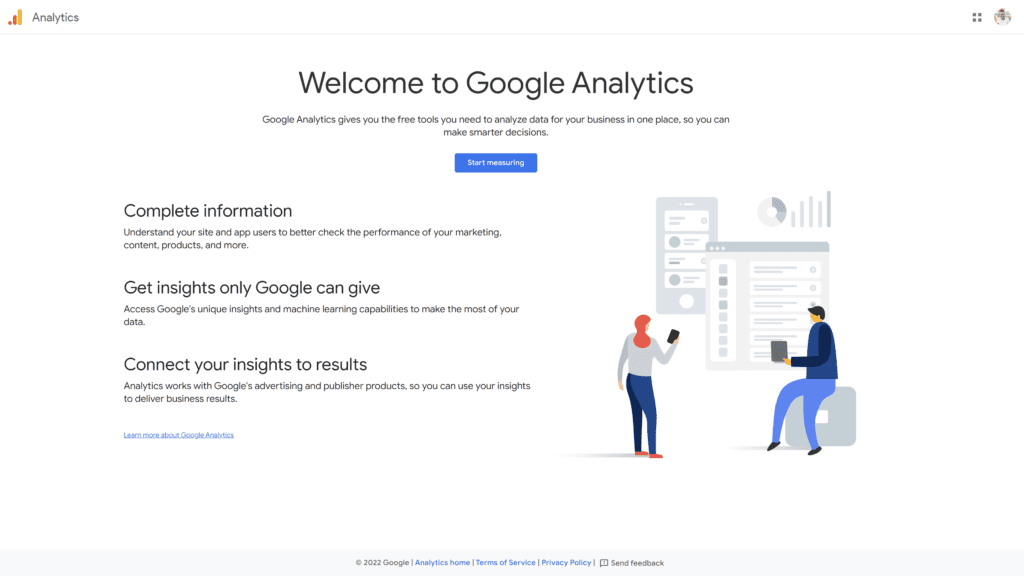
Google Analytics is the heavyweight system among analytics tools, capable of uncovering a great deal of information on practically any website you own. Most businesses use this to track the performance of marketing campaigns after people get onto their site.
Our Rating: 5/5
Best For:
All Businesses (Best Overall)
Notable Features:
- Excellent Campaign Measurement: Google Analytics can track individual campaigns to see the exact performance and how well they convert users into customers. It uses five main parameters to sort this information.
- Track Nearly Everything: Google Analytics can track almost anything a user does on your website, from filling out a form to downloading a white paper. It’s not limited to tracking purchases like some other systems.
- Reporting Options: Google Analytics has many reporting options, from charts showing activity over time to flow visualization tools that show how people are behaving and moving around the site.
Pros:
- Outstanding Insights: Google Analytics offers excellent insights into users, including information on where they’re coming from. This can help you decide where to focus marketing efforts.
- Live Performance: Google Analytics offers nearly-live tracking of people currently on your site.
- User Sorting: Google Analytics can sort users by various demographic information.
- Access to Google’s Database: Google Analytics benefits from Google’s overall knowledge about each user, which makes it easier to understand what they’re doing and why.
- Highly Customizable: It’s possible to customize Google Analytics so it displays the information that’s most relevant to your needs.
Cons:
- Information Overload: Google Analytics has so much information that it can be hard to figure out what to pay attention to and what’s important.
- Manual Setup: Many features in Google Analytics require manual setup and configuration for the best results.
- Cluttered Feed: The displays on each page are relatively cluttered and can be hard to sort through.
Is Google Analytics Hard to Use?
Yes. Google Analytics is extremely powerful, but it takes more time to learn than most of the other options on this list. You may want to hire someone to set this up for you or participate in classes to learn how to use this system effectively.
Pricing & Plans:
- Free: Most individuals and businesses use the free version of Google Analytics, which is suitable for tracking up to several hundred thousand visitors per month. The free version has access to most features.
- Google Analytics 360: The enterprise-level version of Google Analytics starts at $12,500 per month, but uncaps most restrictions. It also allows more customization and better integration with other tools, plus personal account managers and support from the developers.
Our Take:
Google Analytics doesn’t have the kind of slick, simple display system that many other social media tools do, but it’s hard to overstate the sheer power here.
It’s worth using despite the complexity, and even better, it’s free. If you’re large enough to need the paid version, then you’re making enough money that its price doesn’t matter.
Also, many other reporting systems rely on information from Google Analytics but filter the results to display content that’s most relevant to your needs. If you don’t install this, you can’t use other systems to their full potential.
Rival IQ
Overview:

Rival IQ is a social media-focused analytics tool with features like head-to-head analysis of competitors and integration with all of the most popular networks. It includes analysis of posts, audits, reports, and more.
Our Rating: 4.5/5
Best For:
Comparative Analysis
Notable Features:
- Competitive Alerts: Rival IQ can alert you to the actions of competitors so you can try to focus users back on your content.
- Multi-Channel Tracking: Rival IQ offers a single location to track performance on multiple networks, including Facebook, Twitter, and Instagram.
- Google Analytics Integration: Rival IQ can access data from Google Analytics and produce clear, simple reports.
Pros:
- Excellent Reports: Rival IQ offers clear, actionable reports to guide future marketing strategies.
- Social Media Focus: Rival IQ isn’t trying to be everything for everyone like Google Analytics. It focuses on social networks, which is why it’s one of the best social media tools in 2022.
- Competitive Analysis: Rival IQ offers an impressive amount of data on competitors, which is something many other tools lack.
- Easy Comparisons: Rival IQ can simplify comparisons across different timeframes, allowing users better insight into how their campaigns are working.
- Real-Time Responsiveness: Rival IQ can help you see your performance in real-time, including showcasing opportunities for interaction.
Cons:
- Small Network List: Rival IQ is powerful, but only works on a few major social networks. It can’t help with smaller or newer networks.
- Limited Instagram Features: Rival IQ isn’t quite as good on Instagram as it is on the other networks it supports.
- Aggressive Pricing Structure: Rival IQ tries to encourage people to move up in its pricing tiers, which can make it more expensive than it initially appears.
Is Rival IQ Hard to Use?
No. Rival IQ is user-friendly and easy to use with little training. It also helps simplify the display of information from complex sources like Google Analytics.
Pricing & Plans:
- Trial: Rival IQ has a 14-day free trial for testing its services. However, it does not have a fully free tier.
- Drive: The Drive tier is $239/month and allows tracking up to 10 companies at a time. It provides six months of data but does not include some analytics or reports.
- Engage: The Engage tier is $329/month and lets you track 20 companies at a time. It increases the data history to 12 months and offers significantly more reports and connectivity than the previous tier.
- Engage Pro: Rival IQ’s Engage Pro tier is $519/month and allows tracking up to 40 companies with 24 months of data history. It also has a customer account manager who can help provide training, onboarding, and system customization.
- Enterprise: Like most social media tools, Rival IQ has a customizable enterprise tier for larger companies that want to get more.
Our Take:
Rival IQ is an expensive tool for social media analytics, but its specialization and outstanding competitive analysis make it a good option for companies trying to grab any advantage.
Analisa.io
Overview:
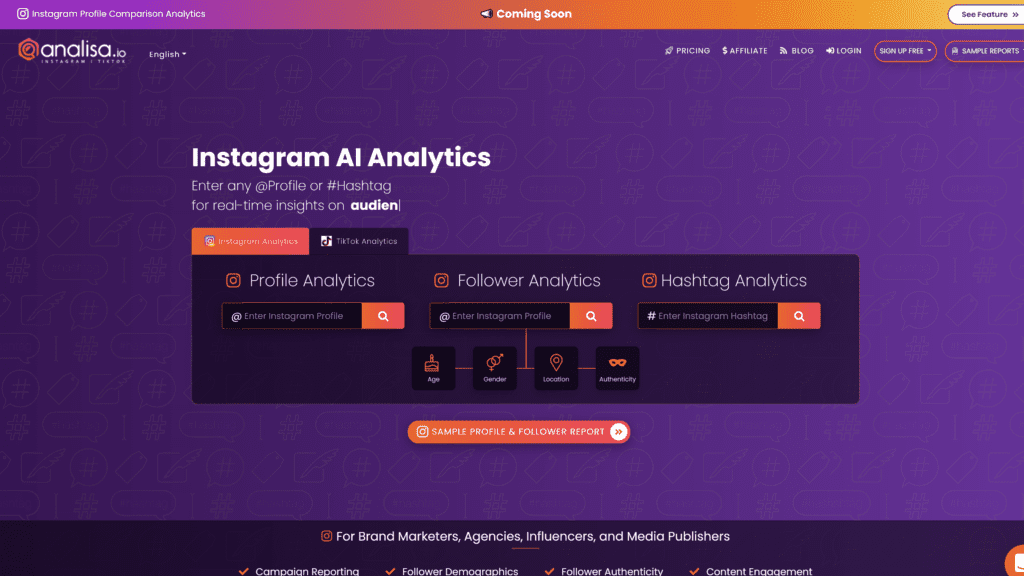
Analisa.io is an AI-based analytics tool for Instagram and TikTok that works for everything from small to enterprise-level companies.
Once set up, it can provide reports on things like hashtags, profiles, and followers to better understand how content is performing.
Our Rating: 3/5
Best For:
Notable Features:
- Competitor Analysis: Analisa.io can analyze competitors on Instagram and TikTok to help companies get a better sense of how to get ahead.
- Demographic Information: Analisa.io can collect valuable demographic information about followers, including verifying authenticity to help cut down on potential fraud.
- Content Optimization: Analisa.io’s optimization services can provide real-time information on the top hashtags, posts, and even posting times.
Pros:
- Excellent Insights: Analisa.io offers a surprisingly high level of insight into competitors at a low price.
- Good Before And After Campaigns: The research tools here are suitable for both planning campaigns and reporting on the results.
- Posting Data: Analisa.io offers information on posts, including the specific times that content gets the most interaction.
- Dedicated Service: Analisa.io focuses entirely on Instagram and TikTok, which allows it to adjust to the unique setup of these platforms.
- Easy Report Generation: Analisa.io’s reports are easy to make and use for presentations.
Cons:
- Limited Audience Information: Analisa.io can gather information from publicly-accessible accounts, but its real data only goes so far and doesn’t have as many insights as other analytics tools.
- Limited Collaboration Tools: Although some parts of the system are good for multiple users, Analisa.io doesn’t have the kind of team-focused integration that others do.
- Pricing: Despite its relatively limited performance, Analisa.io is expensive as a monthly service. It’s mainly worthwhile to buyers trying to find any edge on TikTok and Instagram.
Is Analisa.io Hard to Use?
No. Analisa.io is a relatively simple and straightforward system, so most people can use it well with little training.
Pricing & Plans:
- Free: Analisa.io’s free plan has daily limits on profile and hashtag analysis, with information available only for recent posts.
- Premium: The Premium tier is $69/month and removes the daily limit on profile analysis. It also checks up to 5000 posts per profile or 1000 posts per hashtag, with PDF exports for reports. This tier unlocks most of the activity and performance analysis systems.
- Plus: The Plus tier is $149/month and adds additional exporting options for results and the option to analyze several thousand more posts. However, the primary value at this tier is the addition of dedicated and priority support in case you run into problems.
- Pro: The Pro tier is $239/month and mainly offers additional post analysis to increase the accuracy of reports.
Our Take:
Analisa.io is an excellent analytics program for anyone using Instagram or TikTok.
However, its narrow focus isn’t as good for companies that are posting content on multiple platforms, where a single dashboard tracking everything is more helpful.
This is a specialized tool, so whether it’s valuable or not depends on a company’s situation and goals.
Storyheap
Overview:
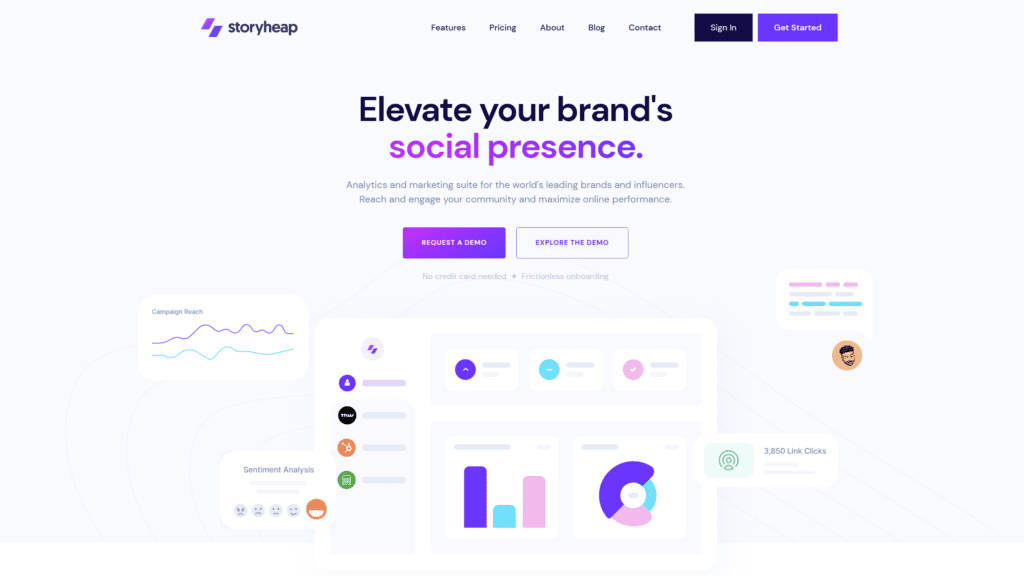
Storyheap is a combination of analytics and publishing services that works across all major social networks.
It can track more metrics than many other providers, includes media editing tools, and even offers AI-based suggestions to help increase conversions.
Our Rating: 4.5/5
Best For:
Multi-Channel Use
Notable Features:
- All-in-One Service: Storyheap offers media editing, post scheduling, content analytics, and more in a single platform. It has more capabilities than most other software on this list.
- Collaboration Tools: Storyheap has collaboration tools that make it easier for teams to work on the content together.
- Automated Structuring: Storyheap makes it easier to automate many processes for Social Media, allowing users to spend more time on other things.
Pros:
- Excellent Management Features: Storyheap is better at managing features than most other services. This is particularly valuable for larger teams.
- Unusual Analytics: Storyheap can track some metrics you usually can’t see in-platform, which is a major improvement.
- AI Suggestions: Storyheap’s AI suggestions can provide input and advice when people need it most.
- Solid Reports: Storyheap offers an excellent selection of reports for users, each of them optimized to display the kind of data it collects.
- Wide Reach: Storyheap works well on many major social media platforms, and the developers aim to expand this over time.
Cons:
- Smaller Service: Despite its features, Storyheap isn’t as well-known as many other companies. Its smaller customer base makes its future less certain.
- No Specialization: Storyheap does many things well, but by spreading itself broadly, it won’t perform in specific categories as well as dedicated services.
- Expensive: Storyheap is significantly more expensive than most competitors, which may be part of why far fewer people use it.
Is Storyheap Hard to Use?
Sort of. Storyheap isn’t fundamentally difficult, but it has so many different features that it will take time to learn all of them and integrate them into your workflow.
Pricing & Plans:
- Trial: Storyheap has a 14-day free trial. The company recommends starting this after a personalized demo, which will help ensure you have the correct settings.
- Starter: The Starter plan begins at $750/month and offers analytics, reports, and campaign scheduling.
- Professional: The Professional tier starts at $2950/month and adds team management and collaboration tools. Storyheap also offers custom development at this tier, which some companies will need to get the most use from the system.
- Enterprise: The custom-price Enterprise tier adds additional integrations, full access to the media studio, and a tailored onboarding process to help people learn the system.
Our Take:
Storyheap is a high-quality service offering many of the functions that modern companies are looking for.
It’s broad enough to replace some other services, but the price tag will be a sticking point for many businesses.
Make sure to get a customized trial as that’s the best way to understand if Storyheap is the right choice for you.
Shortstack
Overview:
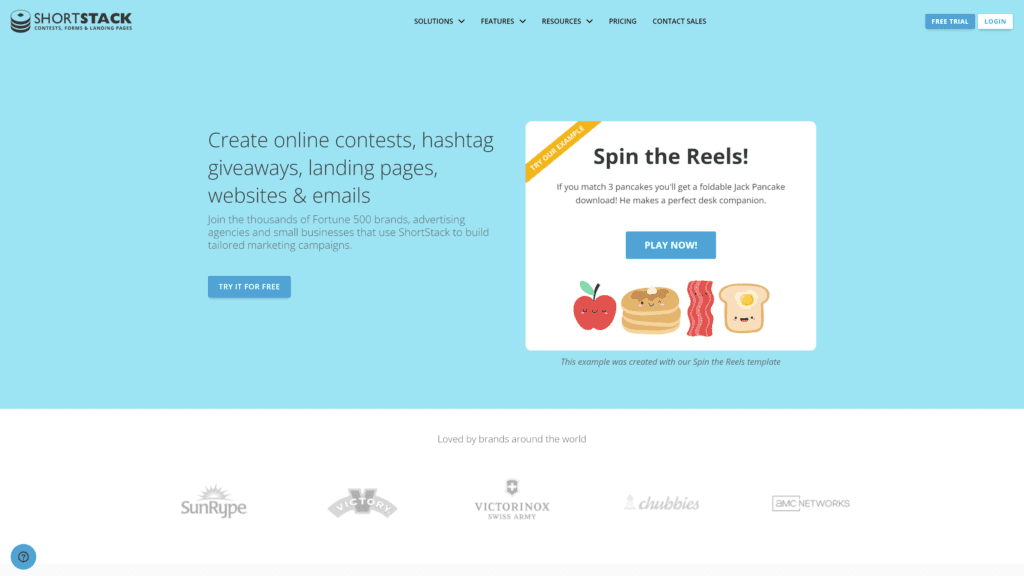
Shortstack is a contest-focused analytics tool. It supports creating contests, giveaways, websites, email campaigns, and more, while simultaneously providing excellent analytics for people who participate in them.
Our Rating: 4/5
Best For:
Businesses Running Contests
Notable Features:
- Large Variety Of Contests: Shortstack supports many types of contests, allowing users to pick the format that works best for their marketing needs.
- Wide Usage: Shortstack works on most major social media platforms, as well as the user’s website.
- Reliably Fair: Shortstack uses a fair decision system to help determine winners, which can help companies avoid any appearance of favoritism.
Pros:
- Highly Flexible Contests: Shortstack’s templates are flexible and easy to adjust so you can match branding guidelines or edit contests as necessary.
- Marketer-Focused: Shortstack caters to marketers, not programmers, and is much easier to use than some other analytics platforms.
- Solid Customer Service: Shortstack has good customer service and responds to most issues quickly.
- Multiple Integration Options: Shortstack uses a webhook system that can link with most email and CRM services.
- Extra Automation: Shortstack can provide additional marketing automation, such as scheduling follow-up emails to contest entrants.
Cons:
- Expensive Unless You Run Contests Regularly: Shortstack is relatively pricey, so you need to set up and run contests frequently to get the most value from it.
- Limited Guidance: It’s not always clear what types of contests will be the most effective for your business. You may have to spend weeks or months experimenting to find out the best option for your company.
- Tricky UI: Shortstack’s user interface can be complicated, and some of its features aren’t easy to find.
Is Shortstack Hard to Use?
Shortstack is moderately complex.
It has several features and will take time to learn, but it’s oriented towards marketers and doesn’t have the complexity that developer-focused systems do.
Pricing & Plans:
- Free: Shortstack’s free version is technically a trial, but has no time limit. It supports 20 entries into contests and 100 views every thirty days, plus most features of the Agency tier.
- Business: Shortstack’s Business tier is $99/month and allows up to 10,000 entries into contests. It supports giveaways, photo contests, essays, and numerous other options, but doesn’t allow for video uploads, hashtag/retweet contests, or campaign analytics.
- Agency: The Agency tier is $249/month and supports up to 50,000 contest entries. This tier unlocks most of the remaining contest types, plus analytics and custom landing page domains.
- Brand: The Brand tier is $499/month and allows up to 500,000 contest entries. This tier is similar to the Agency level but adds digital rights management, collaboration features, and an account manager who can provide personal assistance.
- Enterprise: The Enterprise tier is nearly identical to the Brand tier, but supports more team members, larger videos, and custom templates for sites.
Our Take:
Shortstack is only relevant if you plan to run contests, but it’s easy to use and an excellent choice for any company that does.
As a marketer-oriented platform, it minimizes the need for custom development and allows users to create contests in minimal time.
The analytics on top of this help clarify which contests are worth repeating.
TapInfluence
Overview:
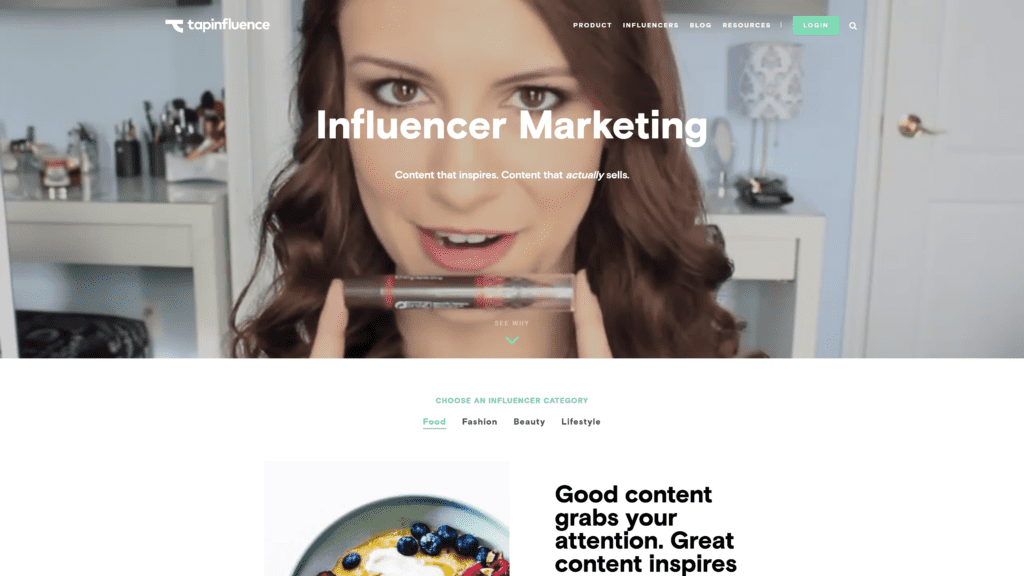
TapInfluence is an influencer-focused campaign manager and analytics platform.
It constantly analyzes potential options and can deliver tailored suggestions in seconds to help you get a comprehensive understanding of your choices and how they may be able to help you.
Our Rating: 3.5/5
Best For:
Influence Marketing
Notable Features:
- Robust Influencer Discovery: TapInfluence offers quick assessments for potential influencers, including data and insights into their audiences. It allows sorting into lists, checking by keywords, and even matching locations.
- Automated Processing: TapInfluence helps automate many aspects of influencer marketing campaigns, from direct offers to scheduling posts.
- Solid Analytics: The internal analytics systems can track performance, detect some types of fraud, and export reports. TapInfluence can link with Google Analytics and most large social media platforms for more information.
Pros:
- Searchable Database: TapInfluence allows searching its huge database of influencers to find the right partners, rather than limiting itself to AI-generated suggestions.
- Good Filters: TapInfluence rates influencers on multiple metrics, then compare them to each user’s business portfolio to see which candidates are the best fit.
- Easy Communication: TapInfluence simplifies the process of contacting influencers and makes it easier for users to evaluate responses.
- High ROI: Influencer campaigns that go through TapInfluence often have a high return on investment, which is the main reason anyone should consider using it.
- Good For Niche Cases: TapInfluence works for niche markets, not just the most popular categories.
Cons:
- Limited Customer Service: It’s not always easy to get ahold of TapInfluence’s customer service team.
- No Contracting: TapInfluence supports communication, but does not support directly contracting with influencers. You must find another way to do that.
- Expensive: TapInfluence is quite expensive for the services it offers, though its tendency to provide a high ROI offsets this.
Is TapInfluence Hard to Use?
TapInfluence is moderately challenging to use.
The searchable database and contact functions are easy enough, but some of its other campaign management systems will take time to learn.
Pricing & Plans:
- Standard: TapInfluence’s Standard tier is usually $1999/month, but they don’t make the current numbers available on their website. You may need to contact them directly to verify if this information is still accurate. The Standard tier includes access to their platform, including analytics and data on past performance.
- Enterprise: The custom-price Enterprise tier is largely the same system, but allows for direct contact with TapInfluence to hand-select influencers and develop marketing plans.
- Agency: Unusually, TapInfluence also has a custom plan for agencies as an integration for other services. This tier provides personalized guidance for pitching things to clients, calculating ROI, and scaling marketing through influencers.
Our Take:
TapInfluence is a good choice for companies looking to expand into influencer marketing.
However, it’s a high cost just to find people to work with and doesn’t include what you’ll be paying for the actual marketing. It works, but only larger companies can justify the costs here.
Also, we don’t like it when companies hide their pricing behind walls, as that’s inherently suspicious.
We dropped their score, despite the quality of their platform, because they’re not transparent with their customers on pricing.
Keyhole
Overview:
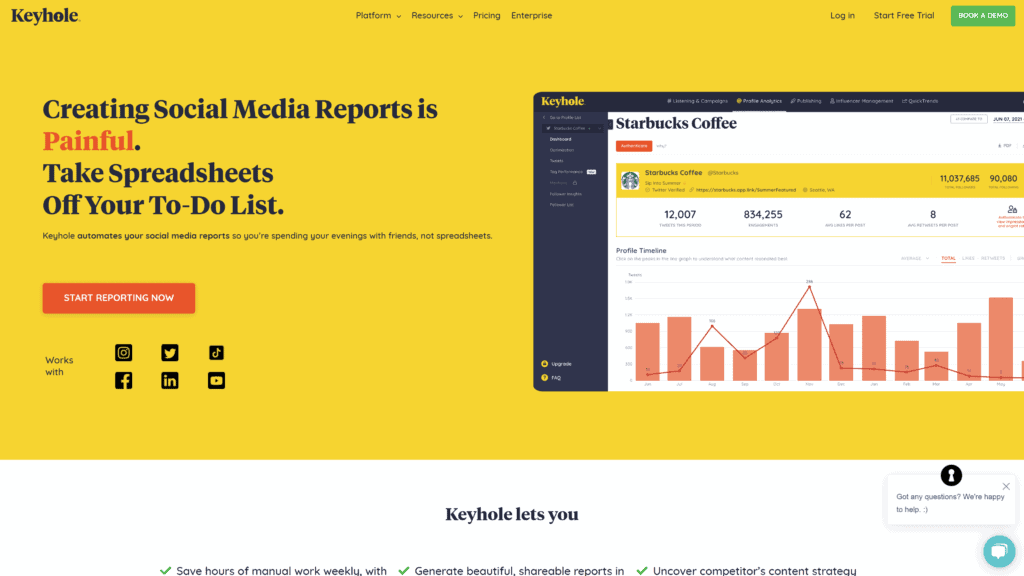
Keyhole is an analytics and reports production platform.
It collects data from social media platforms and other websites, then processes that information to provide useful insights.
Although best at producing reports, it does evaluate and compares some data internally.
Our Rating: 4/5
Best For:
Generating Reports
Notable Features:
- Influencer Authentication: Keyhole has an authentication system for influencers that can confirm their data and provide real-time updates on their performance.
- Flexible Monitoring: Keyhole monitors many types of information, from brand performance to social listening and individual marketing campaigns.
- Easy Report Generation: Keyhole’s primary value is how it makes fast, easy reports about performance on social media.
Pros:
- Comprehensive Dashboard: Keyhole has a fully-featured dashboard with plenty of information available with minimal clicks.
- Competitive Pricing: Keyhole’s pricing tiers are competitive and business-friendly.
- Sentiment Analysis: Keyhole’s sentiment analysis helps track opinions about content, not just interactions. This provides significantly more accurate reports.
- Trustworthy Sources: Keyhole relies heavily on trustworthy and verifiable data sources, particularly the official APIs for major social media sites.
- Tracking Modification: Keyhole allows users to adjust reports and reanalyze data to get more information.
Cons:
- Limited Exports: Some of Keyhole’s report exports, especially to PDFs, will miss information you may want to include.
- Slow Support: Keyhole’s customer support isn’t very fast, especially for users at the lower price tiers.
- Limited Analysis: Keyhole doesn’t check as many social media posts as some other companies, which limits the accuracy of their results.
Is Keyhole Hard to Use?
No. Keyhole is a user-friendly platform with a lot of potential, but most people can learn to use it without much difficulty.
Pricing & Plans:
- Custom: Keyhole has moved to custom pricing for clients of all sizes. Previously, they had a basic plan for $49/month and advanced plans at $99 and $199. Nowadays, they may offer different options and limits depending on your company’s size.
Our Take:
Keyhole is a robust and powerful platform, especially if you want to integrate with other systems and generate reports.
Many large companies use it, which speaks favorably of its performance, and its flexibility is appealing.
However, we don’t like that they have no transparency on their current pricing and we reduced their score because of that.
We believe potential customers should know what kind of price range to expect before contacting a company, not after opening themselves up for a sales pitch.
Management & Automation Tools
Management and automation tools help schedule and control the content you post.
This provides an extra margin of safety and reduces the risk of human error disrupting your schedule.
Buffer
Overview:
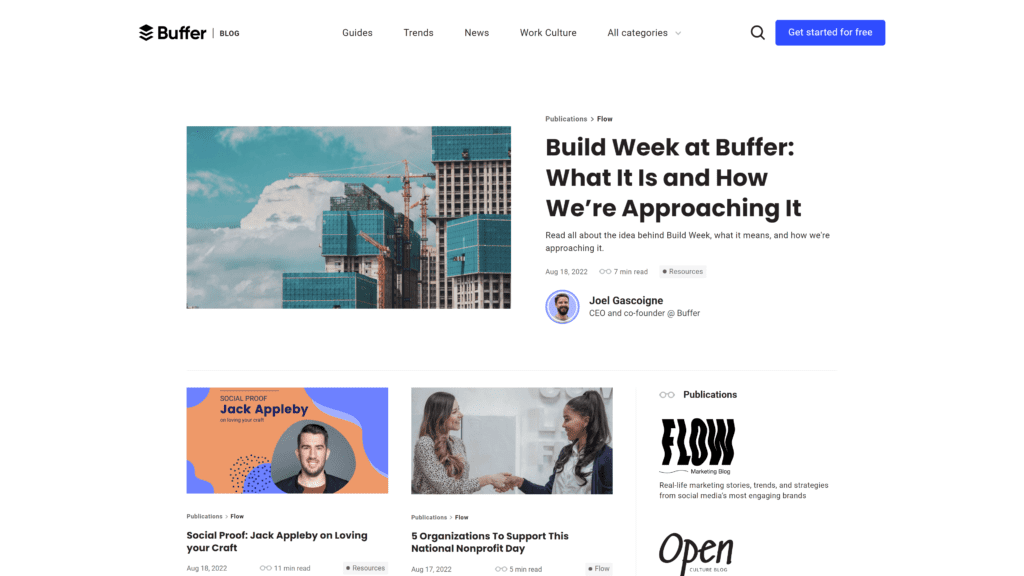
Buffer is a brand-development company with support for publishing, analytics, and user engagement.
Its main focus is looking at user performance, helping plan content, and supporting engagement with customers.
Our Rating: 4/5
Best For:
Brand Building
Notable Features:
- Centralized Analytics: Buffer offers a central analytics platform to track performance on social media.
- Easy Replies: Buffer lets users respond to comments straight from a desktop dashboard. This makes it faster and easier to reply to praise, questions, and complaints.
- Engagement Tracking: Buffer can help managers check engagement with content and see which posts from customers are still unanswered.
Pros:
- Well-Established: Buffer is more than 10 years old and is still operating, which means it’s much more proven than many competing services. Companies that have been around this long are much more likely to keep operating.
- Excellent Scheduling: Buffer makes it easy to schedule content so it goes up exactly when you want it to.
- Role-Based Access: Buffer can limit accounts so people can only access the part of the software they need to use.
- Centralized Control: Buffer operates as a single platform for posting to multiple social media accounts, saving on time and complexity.
- Desktop Access: Buffer has a desktop access system, rather than requiring traditional web access like most services.
Cons:
- Doesn’t Give Suggestions: Buffer isn’t a good tool for figuring out what’s trending or what might perform the best at a specific time.
- Limited Analytics: The internal analytics aren’t good compared to most competitors, so there’s little point in using Buffer for that.
- Post Failures: Buffer sometimes fails to post to social media accounts correctly, so you need to verify each post.
Is Buffer Hard to Use?
No. Buffer is relatively straightforward and most users can learn it without much trouble.
Pricing & Plans:
- Free: Buffer’s Free plan supports up to three channels. It includes some basic publishing tools and a landing page creator, plus post scheduling and integration with many third-party systems. They also have a 14-day trial for the advanced features.
- Essentials: The Essentials plan is $6/month per channel, with up to 2000 posts scheduled at a time. This tier adds analytics and reporting, including a Google Analytics integration for more data.
- Team: The Team tier is $12/month per channel. It allows unlimited users on the account, plus access to draft post management, access permissions, and approval workflow systems.
- Agency: The Agency plan is $120/month for 10 channels, which is the same price per channel as the Team tier. However, it reduces the cost for channels beyond that, making it a better price for agencies that want to manage posts for many clients.
Our Take:
Buffer is a solid content management system, offering a robust set of features for teams and individuals.
The mix of a landing page builder and some analytics tools make it more valuable than systems that only schedule posts, but it’s most effective at the Team or Agency tiers thanks to the collaboration-management controls.
CoSchedule
Overview:
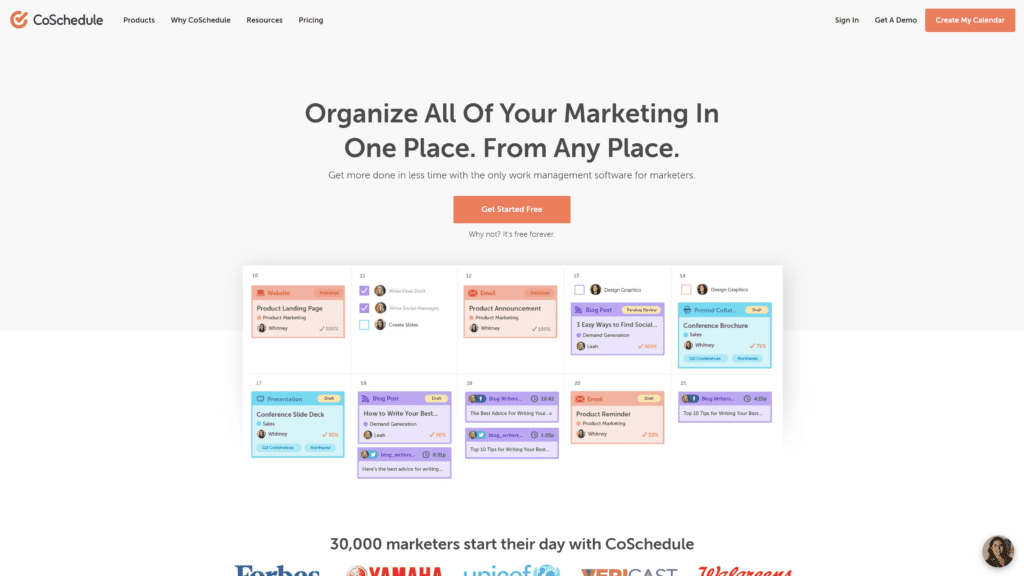
CoSchedule is a work-management platform with several components to help boost performance.
Although individuals can use it, most of its functions are geared toward teams in larger organizations, including its marketing suite and calendar.
Unusually, it also has a training system to help develop marketing skills.
Our Rating: 4/5
Best For:
Organizing Teams
Notable Features:
- Large Selection Of Options: CoSchedule offers support for everything from approval workflows to project templates, marketing campaign management, and content optimization.
- Robust Calendar: The Marketing Calendar includes task management, social media publishing, and numerous integrations.
- Training Center: CoSchedule’s training center offers training in many marketing courses, not just its own controls.
Pros:
- Excellent Schedule View: CoSchedule makes it easy to find gaps in content coverage and look for ways to fill them.
- Great For Large Teams: Most of CoSchedule’s products are geared towards large and complex teams. Most competing products can only handle small teams.
- Regular Updates: CoSchedule is actively developing new services and adds additional tools and options regularly.
- Highly Customizable: Most of CoSchedule’s tools are easy to customize to your needs.
- Read-Only Systems: CoSchedule allows some read-only reports that stakeholders, leaders, and other people can reference as needed.
Cons:
- Slows Down Occasionally: CoSchedule can slow down when you have too many people using it simultaneously.
- No Retroactive Templates: Task templates aren’t retroactive, so if you change something in a format after making it, you have to go and change all of the other tasks to match.
- Relatively Expensive: CoSchedule is more expensive than some competing services, especially with their focus on custom pricing.
Is CoSchedule Hard to Use?
No. CoSchedule is relatively straightforward and they’ve been able to iterate most of the rough spots since their launch.
However, they do have a lot of features, so expect to spend some time if you want to master their platform.
Pricing & Plans:
- Free: CoSchedule offers the basic version of their Marketing Calendar for free. It includes unlimited marketing projects, publishing tools, personal project management, and several other features. They also have a 14-day trial for the advanced features.
- Marketing Calendar Pro: The Pro version of the calendar is $29/month per user, which can add up quickly at larger companies. It adds numerous collaboration options, including team task management and access to priority support.
- Marketing Suite: CoSchedule’s marketing suite has entirely custom pricing, and this is also where most of their features are. Some reports indicate that they have several main tiers for pricing, but they don’t advertise the costs on their website.
Our Take:
CoSchedule is an impressively robust marketing platform for larger teams.
Its focus on larger groups makes it a valuable option for enterprises in an industry that usually caters to smaller marketing teams.
However, we don’t like the opaque pricing for the majority of its features, and CoSchedule has a lower score than it would otherwise get due to this lack of transparency.
HootSuite
Overview:
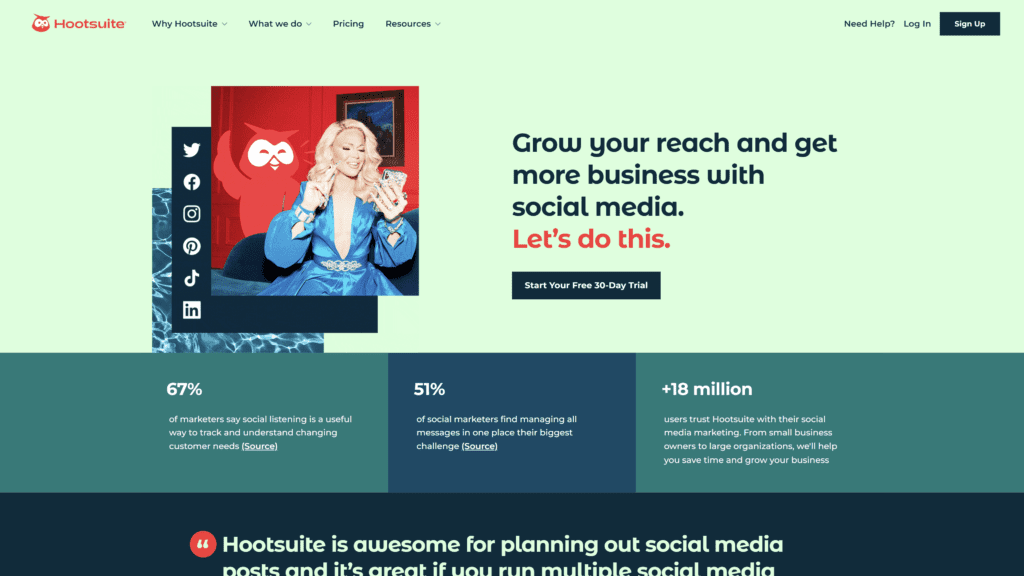
HootSuite is a social media marketing platform.
It includes content scheduling, direct posting to social media, and a centralized inbox for messages and other important content.
Our Rating: 4/5
Best For:
Posting Content
Notable Features:
- Excellent Planning: HootSuite has an excellent content planner, letting you see your scheduled posts with a single glance. It also has a suspension system letting you pause your posts if you need to react to an opportunity or crisis.
- Content Creator: HootSuite’s Composer system helps create posts for different social media platforms. Notably, it can auto-adjust videos to match the height, width, and bitrate requirements for each platform.
- Internal Monitoring: HootSuite’s internal monitoring can help you understand things like how fast employees are responding to customers and who’s performing the best.
Pros:
- Easy Posting to Multiple Accounts: HootSuite uses a simplified posting system to manage accounts and let you post in multiple places at once.
- Access to Media: HootSuite has easy access to images and other material you can use when planning posts for different platforms.
- Flexible Management: HootSuite’s robust software allows companies to use it for one or more categories, including analyzing content and controlling workflows.
- Well-Established Company: HootSuite has been operating since 2008, making it one of the most well-established and reliable platforms for managers.
- Suitable for All Sizes: HootSuite works well across all company sizes, from individuals to corporations.
Cons:
- Requires Good Devices: HootSuite performs best on computers with more than 4 GB of RAM. This isn’t a concern for most personal computers, but it can struggle on many smartphones and tablets.
- PST Default: The scheduling system defaults to Pacific (United States west coast) time, and may require adjustments for other timezones.
- Limited Training: There isn’t much opportunity for one-on-one training to learn the system.
Is HootSuite Hard to Use?
No. HootSuite is relatively simple, which is helped in part by its age.
It started in a time when social media was much smaller, and they’ve carefully managed its complexity in the years since.
Pricing & Plans:
- Free: HootSuite’s free plan gives one user access to two social accounts and five scheduled posts at a time. It’s good for testing HootSuite, but not enough for long-term use. The Professional and Team tiers have a 30-day free trial, while the Business and Enterprise tiers have customized demos.
- Professional: HootSuite’s introductory Professional tier costs $49/month. It supports 10 social accounts, bulk scheduling, message monitoring, and support for post boosting through social media ad systems.
- Team: The Team level costs $179/month and gives support to three users across 20 social media accounts. This tier adds custom branded URLs, suspending scheduled posts, team assignments, and user access permission controls
- Business: The Business tier is $739/month and supports up to five users natively, with additional users available at an extra cost. It also adds departmental organization, message approvals, campaign management, and security compliance integrations.
- Enterprise: The custom-price Enterprise tier supports up to 50 social accounts. It also offers team productivity reports, Single Sign-On, and customized training for users.
Our Take:
HootSuite is deceptively simple looking from the outside.
Although it seems like it focuses on scheduling posts, it has numerous other features and benefits that become obvious for teams. It’s an excellent content scheduler for businesses of all sizes, but especially so for large companies.
MeetEdgar
Overview:
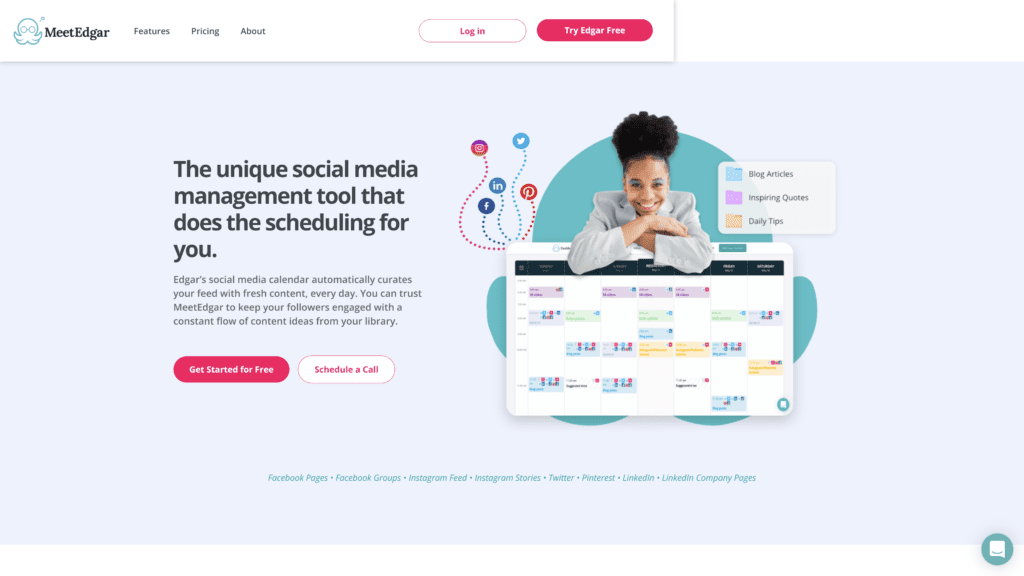
MeetEdgar is an automated posting system designed to minimize the amount of work users put in.
It works on Facebook, Instagram, Twitter, and LinkedIn, but in an unusual step also allows posts to Pinterest.
Our Rating: 4/5
Best For:
Content Automation
Notable Features:
- Automated Scheduling: MeetEdgar can create a schedule for posts for you, drawing ideas from a user-made content library.
- Flexible Time Slots: You can select time slots that MeetEdgar will fill with content.
- Excellent Testing: MeetEdgar supports A/B testing to see which types of content are most engaging across different social media networks.
Pros:
- Content Production: MeetEdgar emphasizes content production, usually posting things on a last-in-first-out setup to ensure the newest material gets posted first.
- Content Variation: MeetEdgar can generate variations on content to ensure a steady supply of new material.
- Categorize Material: MeetEdgar also lets you categorize types of posts and adjust the frequency of each.
- RSS Integration: MeetEdgar allows adding material to your queue through a standard RSS feed.
- Account Management: MeetEdgar can control multiple accounts simultaneously.
Cons:
- Limited Reporting: MeetEdgar doesn’t provide as many reports as most other management platforms.
- Limited Picture Controls: You may not be able to use multiple photos for Facebook posts, which can limit the content you create.
- AI Quality Can Be Suspect: MeetEdgar can generate new ideas based on the things you add to your content library, but it may hiccup occasionally due to limits in the algorithm.
Is MeetEdgar Hard to Use?
No. MeetEdgar is easier to use than most of the other options on this list, especially because it automates most of the workload.
Pricing & Plans:
- Trial: MeetEdgar has a 14-day free trial for its features, but no free mode.
- Eddie: The Eddie plan is the lower-tier option, available for $29.99/month. It supports five social media accounts with unlimited scheduled posts, but just ten weekly automations and four content categories. However, it does allow up to 20 team members.
- Edgar: The higher-tier Edgar plan is $49.99/month. It allows connecting up to 25 social media accounts, with 1000 weekly automations and unlimited categories.
Unlike most other services on this list, MeetEdgar does not have an Enterprise tier for larger teams and companies.
Our Take:
MeetEdgar is most valuable for individuals and smaller companies.
Its ability to automatically schedule posts and generate content from a library removes a lot of the burden of marketing, but it can’t hold up to the needs of larger businesses.
HubSpot
Overview:

HubSpot is one of the largest Customer Relationship Management platforms in the world
It has sections that cover marketing, sales, customer service, content management, and daily operations. It is easily one of the most powerful and versatile options for businesses of any size.
Our Rating: 5/5
Best For:
Marketing and Customer Operations (Best Overall)
Notable Features:
- Extraordinary Support: HubSpot has almost six thousand employees and offers outstanding support to its customers.
- Complete CRM: HubSpot is the closest thing to a complete CRM system, which means it has more features and functionality than anyone else.
- Flexible Setup: It’s possible to use HubSpot for almost everything, but you can limit yourself to specific sections if you prefer.
Pros:
- Excellent Integration: HubSpot is so big that many other platforms can integrate with it. That improves the reach and flexibility of an already top-tier choice.
- Robust Education System: The HubSpot Academy has dozens of courses for marketers and anyone else using the platform. They’re big enough to have heard what people most need to learn, and design courses accordingly.
- Scalable: HubSpot can scale with your growth and continue functioning however large your company gets.
- Outstanding Analytics: HubSpot has great monitoring for the performance of your marketing tools. It also allows segmentation so you can check data in different ways.
- Good Automation: HubSpot has a lot of automation for common tasks, particularly through their Workflows tool.
Cons:
- Expensive: HubSpot can get expensive fast, though its setup as an all-in-one platform means it can replace several other services.
- Setup Time: There’s more to learn on HubSpot than practically any other platform, so expect a longer setup.
- Limited Automation Templates: While the Workflows system can automate many tasks, you’ll have to build a lot of it from scratch or copy what others users make. This is flexible, but it does take some expertise to build up.
Is HubSpot Hard to Use?
No. HubSpot is relatively easy to learn and use, but there’s so much material that it takes time to master.
You can learn most of the basics in a day or two, but people who are new to marketing and CRM may need a month or more to fully learn its ins and outs.
Pricing & Plans:
- Free: HubSpot has free marketing and managing tools, including some that work with ad management, emails, live chats, ticketing, email scheduling, and more. There’s no time limit, but you’ll hit a hard limit once your business grows past too many contacts.
- CMS: The CMS tools range from $25/month to $1200/month for website hosting, domain security, dynamic personalization, A/B website testing, and similar features.
- Customer Service: The Customer Service system ranges from $50/month to $1200/month for meeting scheduling, email management, ticket pipelines and automation, and customer feedback surveys.
- Marketing: The Marketing hub ranges from $50/month to $3200/month for form and email automation, dynamic personalization, A/B testing, video hosting, social media support, custom reports, and team management.
- Operations: The Operations hub goes from $50/month to $2000/month for tool syncing and connectivity, managing multiple currencies, list segmentation, access to webhooks and scheduled workflow triggers, and data quality automation.
- Sales: The Sales hub ranges from $50/month to $1200/month for chat systems, meeting scheduling, sales analytics and automation, and team management.
Most of HubSpot’s plans will increase in price based on the number of additional users or contacts you need.
Our Take:
Despite its high pricing, HubSpot is one of the most powerful and scalable CMS options in the world. It doesn’t have as much customization as some other systems, but it will work for practically any company and remain usable at any size.
Sprout Social
Overview:
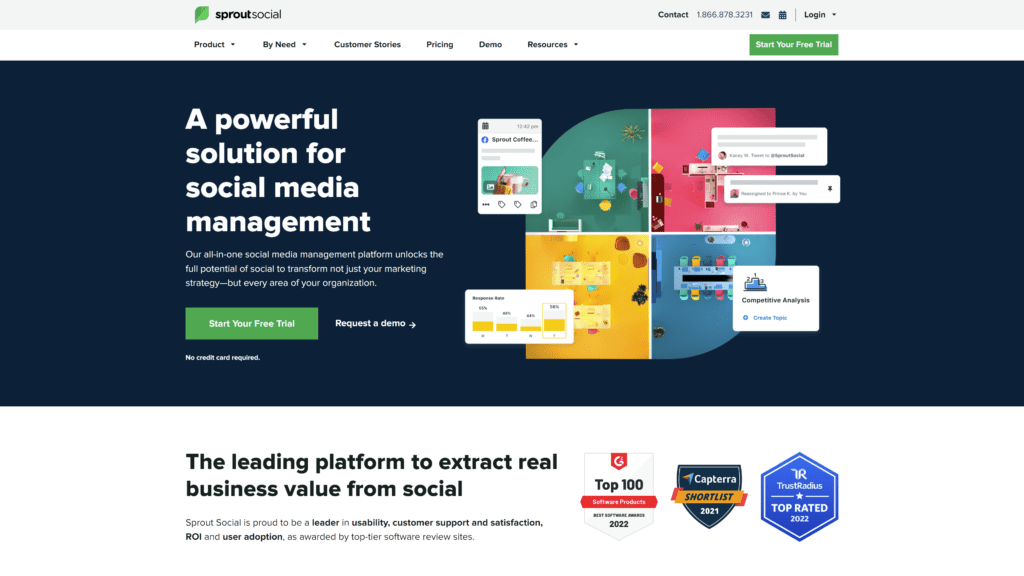
Sprout Social is a social media management platform.
Its sections offer support for media managers, marketing, analysis, and customer support, which work together to improve a company’s overall performance.
Our Rating: 4.5/5
Best For:
Small and Mid-Size Organizations
Notable Features:
- Employee Advocacy: Sprout Social makes it possible to share content through employees’ accounts and create a more unified brand strategy.
- Listening: Sprout’s Listening tools help monitor conversations about social media, including specific brands, to develop actionable information.
- Engagement Tools: Sprout’s engagement system helps smooth and automate customer engagement to increase satisfaction and sales.
Pros:
- User-Friendly Systems: Sprout Social has accessible and user-friendly management tools, so people don’t have to be expert marketers to sit down and get started.
- Excellent Reports: Sprout Social has well-made, easy-to-understand reports to help explain performance to leaders.
- Solid Customer Service: Sprout’s customer service team is responsive and attentive, which is particularly valuable when you’re first setting up.
- Scheduling Suggestions: Sprout Social can make suggestions about when to post content on social media to maximize results.
- Social Media Monitoring: Sprout Social has solid monitoring for social media, including checking for company mentions and posts with certain keywords.
Cons:
- Unnecessary Scaling: Sprout Social occasionally auto-scales pictures even when that’s not strictly necessary, which can be an issue on networks like Instagram.
- Limited Onboarding: There aren’t too many options for onboarding and learning the system.
- Costly: Sprout Social is relatively expensive for the services it offers.
Is Sprout Social Hard to Use?
Sprout Social is not hard to use, but like all management platforms, it will take some time to get used to.
Pricing & Plans:
- Trial: Sprout Social offers a 30-day free trial to learn their system. This is about twice as long as most other platforms that allow a trial.
- Standard: The Standard tier is $99/month per user, supporting five social profiles and an all-in-one inbox. It also includes a post scheduler, a content calendar, review management, keyword monitoring, and multi-level reporting.
- Professional: The Professional plan is $169/month per user, adding support for ten social profiles and competitive reports on the biggest platforms. This level supports custom workflows to allow multiple approvals, response rate analysis, trend analysis, and additional integrations with other software.
- Advanced: The Advanced tier is $279/month per user. It keeps the same number of social profiles, but adds message spike alerts, a digital asset library, chatbots, suggested replies, automated link tracking, and a rule builder for further automating actions.
- Enterprise: The custom-price Enterprise tier is largely the same as the Advanced tier, but offers better pricing for a high number of users at one company.
Our Take:
Sprout Social is a surprisingly powerful platform with plenty of capability for monitoring social media and turning trends into action.
It’s not quite all-in-one like HubSpot, but it’s a solid choice for businesses that can handle the price tag.
Zoho Social
Overview:
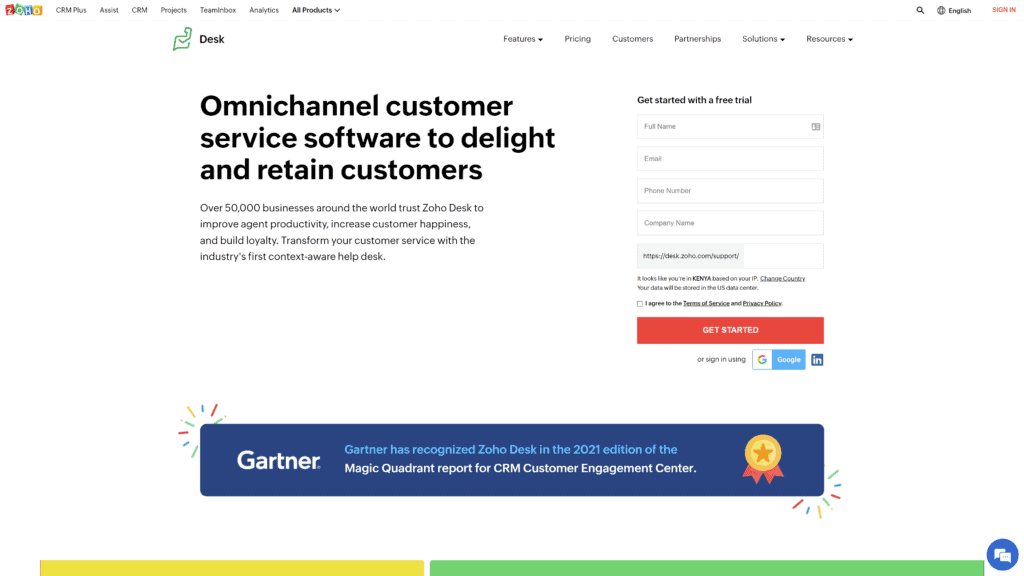
Zoho Social is a brand management platform for social media. Its primary functions include scheduling posts, monitoring performance, collaborating within a company, and analyzing the results of marketing campaigns.
Our Rating: 4.5/5
Best For:
Small Marketing Teams
Notable Features:
- Robust Publishing Calendar: Zoho Social offers a comprehensive scheduler that lets you preview, reschedule, and manage content from a single screen.
- Live Tracking: Zoho Social supports a live feed of engagement in a dedicated window. This makes it faster and easier to respond to questions and conversations.
- Team Support: Zoho Social works well for small teams, particularly with collaboration features that support chat, audio, and video communications.
Pros:
- Affordable: Zoho Social is significantly more affordable than many competing services.
- Excellent Social Listening: Zoho Social’s social listening tools are quite robust and can provide a lot of information about topics currently trending on social media.
- Good Exports: Zoho Social can export calendars into PDFs for easy use elsewhere. This is faster and easier than working with spreadsheets.
- Great Customer Service: Zoho Social usually has live service agents available, which tends to result in faster solutions than email.
- Good Analytics: Zoho Social’s analytics and reports are comprehensive but easy to understand, with a solid selection of customization options.
Cons:
- Limited Plugins: Zoho Social doesn’t integrate with all major platforms. However, it is working on expanding them.
- Expensive: Zoho Social is relatively expensive and often charges per user, which can add up fast at larger companies. That makes Zoho Social better for small-to-medium size businesses.
- Bad For Small Businesses: Although theoretically usable by individuals, the combination of price and features mean Zoho is only best for companies that are managing robust social media campaigns.
Is Zoho Social Hard to Use?
No. Zoho Social is comparatively easy to use, with friendly dashboards.
The Smart Inbox is particularly valuable for keeping track of conversations.
Pricing & Plans:
- Free: Zoho Social’s free tier allows managing one brand across seven channels. It’s essentially a light version of the Standard plan, but with significantly fewer features. There is no time limit on the free plan.
- Trial: Zoho Social has a 15-day free trial to test out its advanced features. It automatically converts to a free plan if you don’t upgrade to a paid level.
- Standard: The Standard tier is $15/month and supports one user, covering one brand and seven channels. It allows content scheduling, checks recent posts, provides summaries, and even offers an image editor for making better posts.
- Professional: The Professional tier is $40/month, with additional users at another $12 each. It has one more channel by default, plus notifications, a media library, the ability to block and mute accounts, bulk scheduling, and information on popular posts.
- Premium: The Premium tier is $65/month, with three team members by default. It supports content approval, collaboration systems, internal discussions, custom reports, and better analytics.
- Agency: The Agency tier is the first of the plans for companies managing social media for others. It’s $320/month but allows five team members to manage 90 channels across ten brands. It also provides free logins and custom portals for clients so they can check on performance.
- Agency Plus: The Agency Plus tier is $460/month, offering 180 channels across 20 brands. It’s otherwise largely the same as the previous tier.
- Enterprise: Zoho Social’s Enterprise tier is primarily for agencies managing 50 or more brands, offering customized pricing for its services.
Our Take:
Zoho Social is a robust and flexible platform, with a surprisingly high number of options and services.
However, its pricing structure can make it prohibitively expensive for larger companies, so it works best for smaller businesses.
Features to Look for In Social Media Tools
Here are the main things to look for when buying social media tools.
1. Ease of Use
Ease of use covers things like how much training people need and how well they can use it on a day-to-day basis.
Platforms that are easy to use are better for larger teams but may lack some of the power and customization of systems like Google Analytics.
2. Price & Affordability
Pricing varies greatly between platforms, with the most expensive options costing thousands of dollars per month.
Good social media tools will provide a positive return on investment, but it’s important to avoid scaling up too quickly.
3. User Seats & Team Access/Collaboration
Most social media tools have options for additional users and collaboration.
However, some platforms are significantly better than others for collaboration.
This is particularly important at larger companies, whereas smaller companies can get away with users sharing an account.
Wrapping Up
There are plenty of social media tools out there, many of which perform several roles at once.
HubSpot and Google Analytics are the best services overall, but other services like Infogram, HootSuite, and Zoho Social can provide compelling alternatives.
Companies have different needs and workflows, so consider testing several platforms before making a final decision.
This takes time, but selecting the best fit for your company (whether you’re an individual or part of a team of hundreds) will make a huge difference in your final ROI.
The sooner you start, the better, so start writing down which platforms seem like the best fit and begin testing them as soon as you can.







